
Top shots
Time to dance


















































When the cuckoo returns, our prettiest spring butterfly takes to the wing. Look out for it on your next visit...
Scan the ditches and damp meadows on our reserves and other wetlands on sunny days for the orange-tip. The roving male, his wing tips dipped in orange, warns off potential predators with his bold appearance. The caterpillars feed exclusively on plants of the cabbage family, and hunting birds quickly learn that this gives orange-tips a bitter, astringent taste – best avoided! Here, an orange-tip sips from lady’s smock. This wildflower is exclusive to wetland habitats and also known as cuckoo flower due to its flowering season of April to June. The shy female, with her black-edged wings, is seen less often, but both sexes reveal a delicate beauty when their wings close, for their underwings are mottled grey-green, like old lichen. Orange-tips overwinter as chrysalises, so their emergence dates from year to year give us a good baseline for recording the effects of climate change.
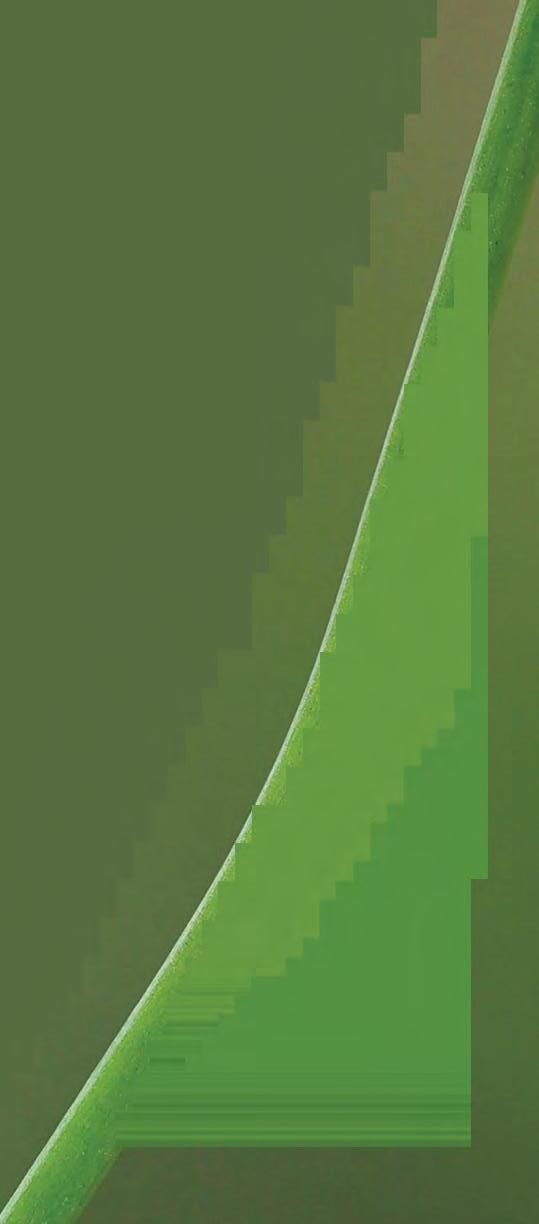
WWT is the leading global conservation organisation committed to the protection of wetlands and all that live in and around them. WWT is the only UK charity with a national network of specialist wetland centres that people can visit. It was founded in 1946 by the late Sir Peter Scott, the renowned naturalist and artist.
HEADQUARTERS
Wildfowl & Wetlands Trust Slimbridge, Gloucestershire GL2 7BT wwt.org.uk membership@wwt.org.uk
Registered Charity No. 1030884 and SC039410
CENTRES
For full location, address and contact details, please visit the individual centre pages on our website – wwt.org.uk/visit
WWT Arundel 01903 883355
WWT Caerlaverock 01387 770200
WWT Castle Espie 028 9187 4146
WWT Llanelli 01554 741087
WWT London 020 8409 4400
WWT Martin Mere 01704 895181
WWT Slimbridge 01453 891900
WWT Washington 0191 416 5454
WWT Welney 01353 860711
WATERLIFE
The magazine of the Wildfowl & Wetlands Trust
Managing editor: Sophie Bursztyn waterlife@wwt.org.uk
Editor: Sophie Stafford sophie.stafford@thinkpublishing.co.uk
Chief sub-editor: Marion Thompson
Art director: George Walker
Contributors: Neil Aldridge, Amy-Jane Beer, Paul Bloomfield, Dominic Couzens, Derek Niemann, Andy Parkinson
Editorial board: Tomos Avent, Jon Boardman, Andrew Foot, Geoff Hilton, Peter Lee, Penny Read, Mark Simpson
Sales executive: Jamie Dawson 020 3771 7201 jamie.dawson@thinkpublishing.co.uk
Client engagement director: Clare Harris, Think Media Group, 20 Mortimer Street, London W1T 3JW; thinkpublishing.co.uk
Front cover: Common frog David Tipling/naturepl.com
Waterlife is published three times a year, and is printed by Walstead Peterborough on Leipa ultraMag
Plus, an FSC® certified paper containing 100% recycled content.
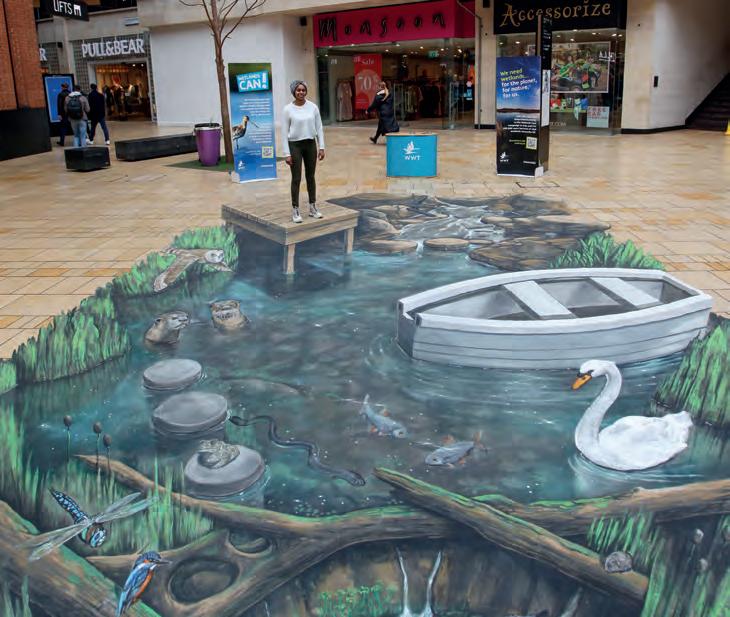
3 One to spot… Look out for the orange-tip butterfly on cuckoo flower – a true sign of spring
4 Welcome and Contents Our Chief Executive, Sarah Fowler, on hope for the year ahead
7 Update WWT conservation news from around the world
17 Waterlines Nature writer Amy-Jane Beer on the delights of immersing yourself in birdsong
18 Your views Your letters, plus our top shots from your photographs
20 ID guide Discover how to identify frogs, toads and newts, as well as a water-loving snake
22 Hope floats Chief Executive Sarah Fowler invites four wetland champions to share their views
28 Photo competition We reveal the incredible winning shots from our annual contest
34 Science in action How our new study is revealing the amazing ways ponds boost wildlife
37 Wild about... great crested grebes Andy Parkinson photographs their spring courtship display
43 Get closer A selection of the best spring events to experience at our centres
50 Back chat Paralympic gold medallist Jo Frith on finding peace in wetlands


MIX .../ .,_,.) Paper from FSC responsible sources wwwfsco,g FSC® C010219
Views expressed in the magazine do not necessarily reflect those of WWT.
ISSN: 1752-7392

Turn to page 43 to see our new-look section on experiences and events at our centres






This year is one of hope, I can feel it in the caress of the spring sunshine. Whenever I get the chance to step outside my office and into nature it makes such a huge difference to my day. The air is alive with birdsong, families of gawky ducklings zigzag across the paths, and everywhere trees are in blossom and flowers are in bloom. It lifts my spirits like nothing else. I know how lucky I am to work in a wetland!
But my feeling of hope doesn’t just stem from the arrival of spring. We’ve already set ourselves the task of restoring 100,000ha of wetland in the UK with the help of our partners, and I am confident that, together, we can achieve this goal – as well as even greater things. WWT has big plans and ambitions for the year ahead.
We’re so proud to have the advocacy of many great ambassadors for wetlands – and this year we welcome actor Sir Mark Rylance and conservation campaigner Lucy Lapwing and thank them for their support. In this issue, I’ve invited them and other leading experts to share their views on the exciting opportunities for change that lie ahead.
However, there’s no doubt there are challenges for us all, not least the rising cost of living alongside the effects of the climate and biodiversity crises. Like everyone, WWT’s costs have risen substantially over the past year and as a result we need to increase our membership prices from 1 April. We hope you understand.
Yet now is the time to make the changes in the world we want to see. We can’t do it alone – we need you. A big challenge for us is opening eyes and hearts to the power of nature-rich wetlands, and you – our members – have a key role to play in sharing your love for wetlands. Many of our members are talented photographers and their images are their voice. The finalists in our annual photo competition showcase the beauty of our wetland wildlife.
Sarah Fowler, Chief Executivei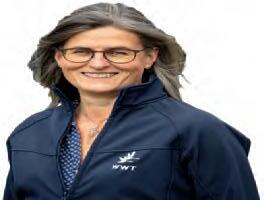


…and give back to wetlands and wildlife with every purchase. wwt.org.uk/shop
To learn more and request your free Guide to Gifts in Wills, please contact our Legacy Team via gft sinwills@ wwt.org.uk, on 01453 891150 or visit wwt.org.uk/gft s-in-wills





Grantown-on-Spey



















As soon as you walk into the Grant Arms Hotel you realise it isn't just any four star Hotel. In short the refurbished Grant Arms is the hotel for bird and wildlife watchers offering wonderful food, friendly staff and 50 high quality ensuite bedrooms. All bedrooms come with hairdryer, colour TV, toiletries and coffee making facilities.
Speyside and the Cairngorms are one of the best areas for wildlife watching in the UK. Perfect for beginner to expert, whether for a day or a fortnight. Depending on the season you could see: Golden Eagle, White-tailed Eagle, Pine Marten, Red Squirrel, Mountain Hare, Osprey, Ptarmigan, Otter, Red and Black Grouse, Red and Roe Deer, Slavonian Grebe, Crested Tit and Crossbill, as well as Dolphins, Waders, Sea Ducks and Sea Birds along the Moray Firth coast.
Guests have free use of the BWWC Information Centre, Club Room and Library. BWWC staff are available at Breakfast and in the Evening to help you make the best of your holiday whilst leaving you free to do what you want.




ByTrain:TheneareststationisAviemore(15miles)ontheEdinburgh-Inverness line.
By Plane:InvernessAirport(30 miles)- FlightsfrommostmajorUK airports: LOGANAIRfromBirmingham,Manchester,BelfastCityandAberdeen;KLMfrom Amsterdam;EASYJETfromBristol,Gatwick,LutonandBelfastInternational;BAfrom Heathrow.OtherdestinationsavailablefromAberdeenAirport(75miles).
......_.;;._ _ _, Togetthemostoutoftheareayouneeda car.

Otherlengthsofstayarealsoavailable.Dogswelcome£20perroomperstay.Single, Twin,Double,Family& WheelchairAccessibleRoomsavailable.SpecialRatesfor Clubs,Tours& Conferences.Terms& Conditionsapply.



Critically Endangered European eels and true fox-sedge, a rare wetland plant, are among species that could benefit from large-scale habitat recovery work – planning for this starts this year in the Severn Vale.
The innovative Eelscapes project aims to restore a series of connected, naturally functioning, climate-resilient floodplain wetlands in western Gloucestershire, supporting the recovery of iconic and threatened plants and animals.
Communities alongside the floodplains could also benefit from improved resilience to the impacts of climate change, more possibilities for recreation and connection with nature, and new sustainable business and investment opportunities.
“This scheme represents one of the most exciting and ambitious opportunities for large-scale wetland conservation in my lifetime,” says WWT Senior Project Manager Ellie Jones. “In the face of growing climate pressures, it is more important than ever
that we shine a light on the multiple benefits that healthy wetlands provide to both people and wildlife.”
Over the next two years, we’ll undertake assessments and modelling to shape our plans and secure potential pieces of wetland restoration work.
We hope the Eelscapes project, which we’re leading alongside partners Gloucestershire Wildlife Trust, the Environment Agency and 14 land managers, will demonstrate how landscape-scale conservation can be delivered across areas of complex and multiple land ownership. This project is funded by Natural England under a Defra Landscape Recovery Project Development Grant.
“It is more important than ever that we shine a light on the multiple benefits that healthy wetlands provide”
Eelscapes is just part of our work –alongside local partners Floodplain Meadows Partnership and FWAG-SW, volunteers and landowners – to nurture floodplains in the Severn Vale, the globally important wetland described by WWT founder Sir Peter Scott as the ‘Serengeti of the UK’. We’re working alongside farmers to learn about the movements, and protect the nests, of threatened curlews, some 35 pairs of which breed in the Severn Vale. Together with amazing volunteers and farmers, we’re identifying and restoring wildflower-rich floodplain meadows and studying how vanishing farmland ponds boost wider biodiversity (see page 34). And we’re inspiring local landowners and communities to take up the baton and contribute to wetland conservation and wildlifefriendly farming. Find out more at wwt.org.uk/flourishing-floodplains

Tom Fewins, WWT Head of Policy and Advocacy, shares the latest on our work building political and wider support for wetlands
With spring approaching, the events of last year are fading fast into memory. This includes major international environmental conferences where three critical summits came almost all at once. Last November and December, these ‘Conferences of the Parties’ – or COPs – included the Ramsar Convention on Wetlands summit in Geneva (COP14), the UN climate summit in Sharm el-Sheikh (COP27) and the UN biodiversity summit (COP15) in Montreal.
These summits were an opportunity to raise awareness of the critical importance of wetlands to the world, and to build a platform for further global efforts to save them. While the outcomes were not perfect it was heartening to see progress made. At the biodiversity summit this included countries signing up to a new Global Biodiversity Framework that specifically recognised the importance of wetlands to restoring the world’s disappearing wildlife.


Adding their support to World Wetlands Day: David Lindo, Kwesia, Mike Dilger and WWT Steart Marshes Site Manager Alys Laver, and
This was a big win for wetlands. However, now the hard work must start back home, turning these pledges into action that ensures the UK best protects and manages existing wetlands as well as redoubles efforts to restore them. This is essential if we are to meet both international commitments and domestic targets to address the climate and nature crises.
Over the past two years WWT has set out how this can be achieved via partnership working, a stronger policy framework, greater political commitment and wider public support. And over the coming year, we will – with your help - continue to press for these, and work to ensure that wetlands become part of our future, rather than – like the COPs of 2022 – just another distant memory.
We had a busy World Wetlands Day this year, taking a stunning wetland vision to the heart of one of the UK’s biggest cities. Theawarenessday,celebratedon2February eachyear,involvedtheunveilingofagiant, colourful,immersive3Dwetlandmuralin CabotCircusshoppingcentreinBristolto engagepeoplewithwhatwetlandsareand whytheymatter.
Wetlandscleanourwater,protectus againstfloodinganddrought,capture carbon,providehomesforawealthof wildlifeandboostourhealthandwellbeing –yet45%oftheBritishpublicdon’tknow whatawetlandis.Wewanttochangethat.
Hundredsofpeopleinteractedwiththe 20ftmural,takingtheirphotosintheboat, onthejettyorbalancingonthestepping stones.Themural,whichisnowtouringthe
Forty-five per cent of the British public don’t know what a wetland is. We want to change that
UK,showsadegradedwetlandtransforming intothrivingwetlands–includingsaltmarsh –fullofwildlifefromottersandeelsto natterjacktoadsandcurlews.
Theartwork,by3DJoeandMax,was unveiledaspartofadayofactionduring whichWWTAmbassadorsDavidLindo (TheUrbanBirder)andTVpresenterMike DilgerwerejoinedbyKwesia(CityGirlin Nature)andspokepassionatelyaboutwhat wetlandsmeantothem.Youmayhave spottedusontheBBCorITVnews!
Over1,500morepeoplesignedour WetlandsCan!pledgetohelpuspushfor 100,000morehectaresofwetlandinthe UK.Wenowhavealmost14,000pledges. Ifyou’venotyetsignedthepledge,youcan dosoatwwt.org.uk/world-wetlands-day
Meanwhile,justuptheroadatour SlimbridgeHQ,EnvironmentMinister TrudyHarrisonmetwithourChief Executive,SarahFowler,tolearnmore aboutourBlueRecoveryambitions–and whyweneedtoprotect,restoreandcreate morewetlandsfortheplanet,fornature andforus.

Because your garden wildlife are more than just visitors ............. ,/ Order now \. f and save up to \ \ 25% on the food • they really love! Ark

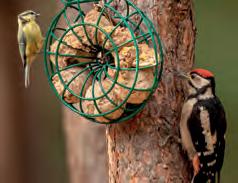


Evidence is growing that nature prescribing courses aren’t just ‘nice to have’, they’re effective in improving mental health


We know that spending time in nature, particularly near water, can help improve mental and physical health. Now a report suggests that ‘Blue Prescribing’ – offering access to wetland activities for people suffering mental health problems –could also be great value, too.
For some years, WWT has been involved in Blue Prescribing – an innovative, naturebased health programme that aims to get people who are experiencing poor mental health outside and enjoying the benefits of engagement with wetland nature. Our courses, delivered at WWT Steart Marshes in Somerset and WWT London Wetland Centre, are specifically designed in consultation with participants to promote a range of mental and physical health benefits. Over several weeks, each person involved enjoys opportunities to get active, spend time with wildlife and connect with other people in wetland settings.
Having evaluated the impact of Blue Prescribing on participants at Slimbridge Wetland Centre, we launched an in-depth study of the social value of the project at Steart Marshes in the year to July 2022. This was possible thanks to funding made available by the Government’s Green Recovery Challenge Fund. The study not only looked at responses from people involved but also measured the social
return on investment – a way of comparing the costs of Blue Prescribing against the predicted value of its impact on participants.
A large proportion (70%) of those who took part in the programme reported a reduction in feelings of anxiety. Six out of 10 people felt better able to manage their mental health, feeling more empowered; the same proportion said they were enjoying life more. Half experienced an improvement in their physical health, and 5% were able to come off medication after taking part in a course at Steart.
Though the methodology used in calculations is not an exact science, the results of the study suggest that every £1 spent on WWT Blue Prescribing and wider activities in Steart yielded £9.32 of ‘social value’ for participants.
Find out more about Blue Prescribing at: wwt.org.uk/blue-prescribing
“I feel happy and calm here. Truly at peace. The [starling] murmuration over the water in the sun was stunning”
Blue Prescribing course participant

We continue to carefully monitor the birds in our care and those visiting our wetland reserves, in response to the spread of avian influenza. Protecting these birds is our priority, so we are undertaking precautionary measures at our wetland centres, following the latest advice from experts and Government agencies.
Wild birds face multiple threats globally, from habitat loss and degradation, climate change and more. WWT continues to fight for better protection for them and the wetland habitats on which they rely, so that they have more resilience to cope better with the additional threat from disease.
For the latest avian flu information, visit: wwt.org.uk/avian-flu

We’re delighted to welcome two new WWT Ambassadors, both avid nature lovers and advocates for environmental protection and action.
Sir Mark Rylance is renowned as an Academy Award-winning actor, playwright and theatre director, star of such films and television programmes as Bridge of Spies, The BFG and Wolf Hall, along with numerous lauded Shakespeare productions. But he’s also a passionate environmentalist with whom we’ve worked before.
“I’ve been a supporter of WWT for some time,” reflects Sir Mark of his involvement with the charity, “and I’ve been hugely impressed with its Blue Recovery work, which promotes wetlands as an effective way to fight climate change, prevent flooding, improve water quality and boost human health and wellbeing. I’m looking forward to getting more people excited

about wetlands, and helping the organisation to realise its ambition to restore and create 100,000 hectares of wetlands across the UK.”
Our second new Ambassador is naturalist, birding expert and self-confessed ‘nature nerd’ Lucy Hodson, who broadcasts and posts as ‘Lucy Lapwing’. “I’m passionate about connecting people to the weird, freaky, beautiful and funny species we share our lives with,” explains Lucy. “I’m so proud to be working with WWT in helping to ignite that passion in others, particularly for wetland wildlife.”
Sir Mark and Lucy will be sharing their love for wetlands, and our efforts to protect and restore this vital habitat. Meet them, along with fellow Ambassadors Ollie Olanipekun and Nadeem Perera of birdwatching collective Flock Together, at: wwt.org.uk/ambassadors
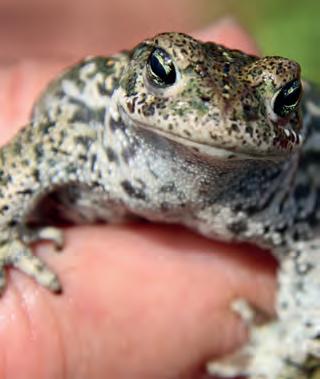

Almost 14,000 of you have signed our Wetlands Can! campaign to help restore and create wetlands

We’re jumping for joy at the success of ongoing habitat restoration work and a reintroduction project to boost numbers of rare natterjack toads at our Caerlaverock reserve. Natterjack populations have fallen across the UK over the past century, hit by habitat loss. WWT Caerlaverock has one of the strongest populations in the northern Solway region, and the largest extent of good natterjack habitat in Scotland. Even here, though, numbers have dropped in the past 15 years.

27 1965
The use of lead gunshot in and around wetlands is now illegal in 27 EU countries, which should save the lives of millions of birds
In 2022, the first Bewick’s swans arrived for the winter in Slimbridge on 10 November, their latest ever migration arrival since 1965
So we’ve undertaken work to improve ponds for breeding natterjacks, which like shallow (and therefore warmer), newly cleaned-out ponds that are not too weedy. In addition, 200 toadlets were taken into captivity, with the aim of raising them to adulthood for release back onto the reserve.
This summer, 45 adult natterjacks were released in Caerlaverock and a neighbouring site – coinciding with one of the most successful breeding seasons for years. The pond improvement works really paid dividends, too: many singing male natterjacks were heard, and 25 spawn strings were found in a number of ponds. More habitat work is planned, with two new ponds created over the past winter. Now reserve staff are looking forward to the first warm, still evenings of spring, when the tantalising, creaking purr of courting natterjacks will drift across the landscape once more.


Wetlands worldwide received a triple boost late last year with positive outcomes from three key international conferences –so-called COPs – thanks in part to WWT advocacy and campaigning work supported by you.
InNovember,alleyeswereonSharmel-Sheikh, Egypt,forthe27thConferenceofthePartiesto theUnitedNationsFrameworkConventionon ClimateChange,orCOP27–unsurprisingly, withtheglobalimpactsoftheongoingclimate crisisincreasinglyclear.Yetitwasjustoneof threeCOPsinquicksuccession–allpotentially contributingtothesafeguardingandrestoration ofwetlandhabitatsandspecies.
EachCOPisameetingofrepresentativesfrom countriescontractedtotherelevantconvention addressingglobalissues.Thefirst,ahybridevent inWuhan,ChinaandGeneva,Switzerland,was theRamsarConventiononWetlands,COP14, focusingontheconservationandsustainableuse ofwetlands.Amongthekeyoutcomeswasthe resolutiontoenhancesynergieswithother environmentalconventions.Inotherwords, countriesagreedtocollaboratemoreeffectively andsupporteachother’sgoalstoimprove outcomesforwetlands.
Thesecondandmost-publicisedevent, COP27,resultedinanewpactthatincludeda pushforacleanenergymix,andapromiseby wealthiercountriestocontributetoafundtohelp
therecoveryofnationsmostseriouslyaffected bytheimpactsofclimatechange.Significantly, thefinalagreementformallyrecognisedforthe firsttimethevitalimportanceofnature-based solutionstotheclimatecrisis–thatpreserving andrestoringhabitatsisacrucialweaponinour fightagainstclimatechange.
LastcametheUNbiodiversityconference, COP15.ThenewGlobalBiodiversityFramework agreedinMontreal,CanadainDecembershould beasignificantstepforward–notleastbecause wetlandsreceivedstrongrecognitionasoneof themostimportanthabitatsrequiringnotjust effectiveconservationandmanagementbutalso activerestorationaspartofmeetingthetargetto restore30%ofdegradedecosystemsby2030.
We’llbepushingtheUKGovernmenttoact onthesecommitments,andwillcontinueto developrelationshipswithoverseasgovernments andagencies.OurnewlylaunchedWWT WetlandLearningHub,offeringprofessionalsin governmentandotherorganisationsworldwide accesstothelatestknowledgeandguidance,will helpgovernmentstakeactiontomeettargets.
It’sgreattoseehowthelong-termpolicyand advocacyworkundertakenbyWWTand partnerscontributestosuchresults–further enablinginitiativessuchasourBlueRecovery project,aimingtorestore100,000haofUK wetlands,andourglobalhabitatprotectionwork inplacessuchasMadagascarandCambodia.
We’re delighted to be sharing our expertise and experience in wetland restoration, management and engagement with partners across the globe through the new World Coastal Forum (WCF). WWT has pushed for the creation of the WCF, which was also mooted as part of various international agreements such as Ramsar and the IUCN World Congress.
The idea is to bring together science, evidence-based best practice and opportunities for coastal conservation around the world, helping to facilitate and upscale local and national efforts. As well as sharing our expertise and evidence for the successful conservation, restoration and management of coastal ecosystems, the WCF will promote international collaboration, support such work in developing countries and enhance engagement with local communities.
The WCF is currently in the pilot phase, but a full launch is planned for 2023. Find out more at: worldcoastalforum.org

Walking is one of the most beneficial forms of exercise, and also one of the most underestimated in terms of well-being. It's a great way to reach the recommended level of physical activity needed to stay healthy without the toll to joints, ligaments and muscles that more demanding sports exact.
When taking longer walks however, same of us can experience skeletal and muscular discomfort. Paul Goddard, 62, a Nordic Walking instructor from Saffron Walden in Essex, swears by a product called Turmeric+ as an effective means of keeping him active.
"I decided to become a Nordic Walking instructor in 2009 and started walking forty to fifty miles
a week. Two years ago it became uncomfortable to walk distances that should have been easy for someone of my age and fitness levels. I felt very apprehensive as walking is not only my passion, but my business."
be helpful and bought supplements and then stumbled upon Turmeric+." Curcumin, the active ingredient in turmeric, is dif-licult for the body to absorb, Some turmeric products offer high levels of curcumin but unless this is easily absorbed by the body, the higher amounts make little difference. The need for easy absorption is what led the scientists at FutureYou Cambridge to create Turmeric+ using the patented 'Curcuma Phospholipid Complex' formulation. It's thirty
times more absorbable than standard turmeric and contains vitamin C, which contributes to normal collagen formation for the normal function

that 'light-bulb' moment - I realised my knees felt like they used to. I take Turmeric+ religiously now. I of cartilage.
Paul continues: "I started doing some research. I learned that turmeric could "Soon after taking it I experienced walk around two hundred miles a month and even my customers have remarked on my mobility.
FutureYou Cambridge is offering you the opportunity to try its bestselling joint supplement, Turmeric+, for free, for 28 days.*
The Cambridge-based company is renowned for developing the highest quality health supplements backed by leading scientific research and actively work with highly-regarded scientific and nutritional experts.
Turmeric+ contains the most scientifically documented bioavailable curcumin formulation in existence, having been the focus of 45 human studies involving
over 2,000 subjects. It has also been officially recognised and certified by Informed-Sport.
Pharmacokinetics studies show the unique phytosome delivery system significantly increases curcumin absorption by 30 times; offering an advanced natural alternative to black pepper. The vegan-friendly formula contains the full bouquet of curcuminoids including high levels of demethoxycurcumin (DMC), the most powerful curcuminoid. It has also been combined with vitamin C and D which contribute to normal function of cartilage and

normal muscle function.
'We want to support more people to become or stay active. We think Turmeric+ can play an important role in that journey.' says Adam Cleevely, FutureYou Cambridge's Chair.
'We offer people their first pack of Turmeric+ for free so they can experience Turmeric+ for themselves. Most will know if it's working for them within four to eight weeks - and if they like it, they will stick with it.'
'

We’ve launched two ambitious new projects and are celebrating great results for two of our campaigns, thanks to your support and generous awards of funding from government and corporate donors

A big thank you to everyone who donated to our Christmas appeal. Monies raised were immediately put to good use during the festive season, helping to keep our centres in tip-top condition, provide food for wild birds and support our general conservation work for wetlands. Birds that spent winter in the UK are now on their way back to their breeding grounds, where we hope they have a successful season. We are very aware that times are tough, so we especially appreciate everyone who donated to the appeal.
Efforts to help communities and wildlife in the River Thames catchment area have been boosted by £1.5m of funding to support the delivery of natural flood management projects. Funded by the Thames Regional Flood and Coastal Committee, WWT will be facilitating local authorities, community groups and others to use this money to devise and deliver the most effective schemes to reduce flood risk – benefiting people and habitats downstream in both urban and countryside environments over the next four years.

After over 10 years of campaigning by WWT and others, the UK Government will finally implement key legislation passed in 2010 requiring new developments in England to include mini wetlands. Rain gardens and ponds capture and slow rainwater and help prevent flooding. Not only will this decision provide £3bn in reduced flood damages, it will improve people’s wellbeing by putting blue space in urban areas. WWT will work with the Government to ensure implementation delivers the maximum benefits for wildlife and people.
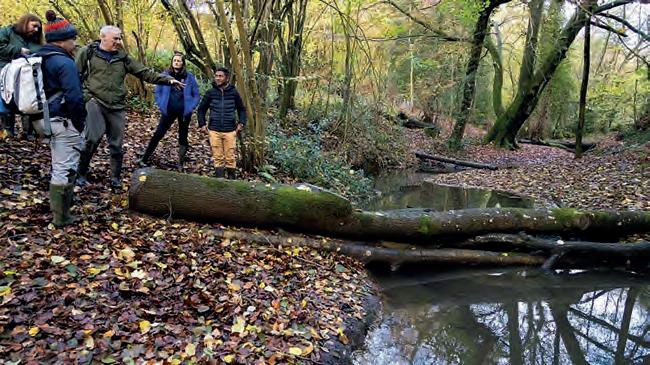
We’re always looking for opportunities to help others benefit from natural flood management


In 2022, WWT received an incredible £1m of unrestricted funding, awarded by the Postcode Planet Trust, from players of People’s Postcode Lottery – who have now raised a total of over £4.8m in support of our work. Player funding is essential in delivering our programme of conservation projects, as well as supporting the day-to-day work of our amazing staff and volunteers who keep our reserves in the best possible condition for wildlife, inspiring children and adults at our wetland centres around the UK.

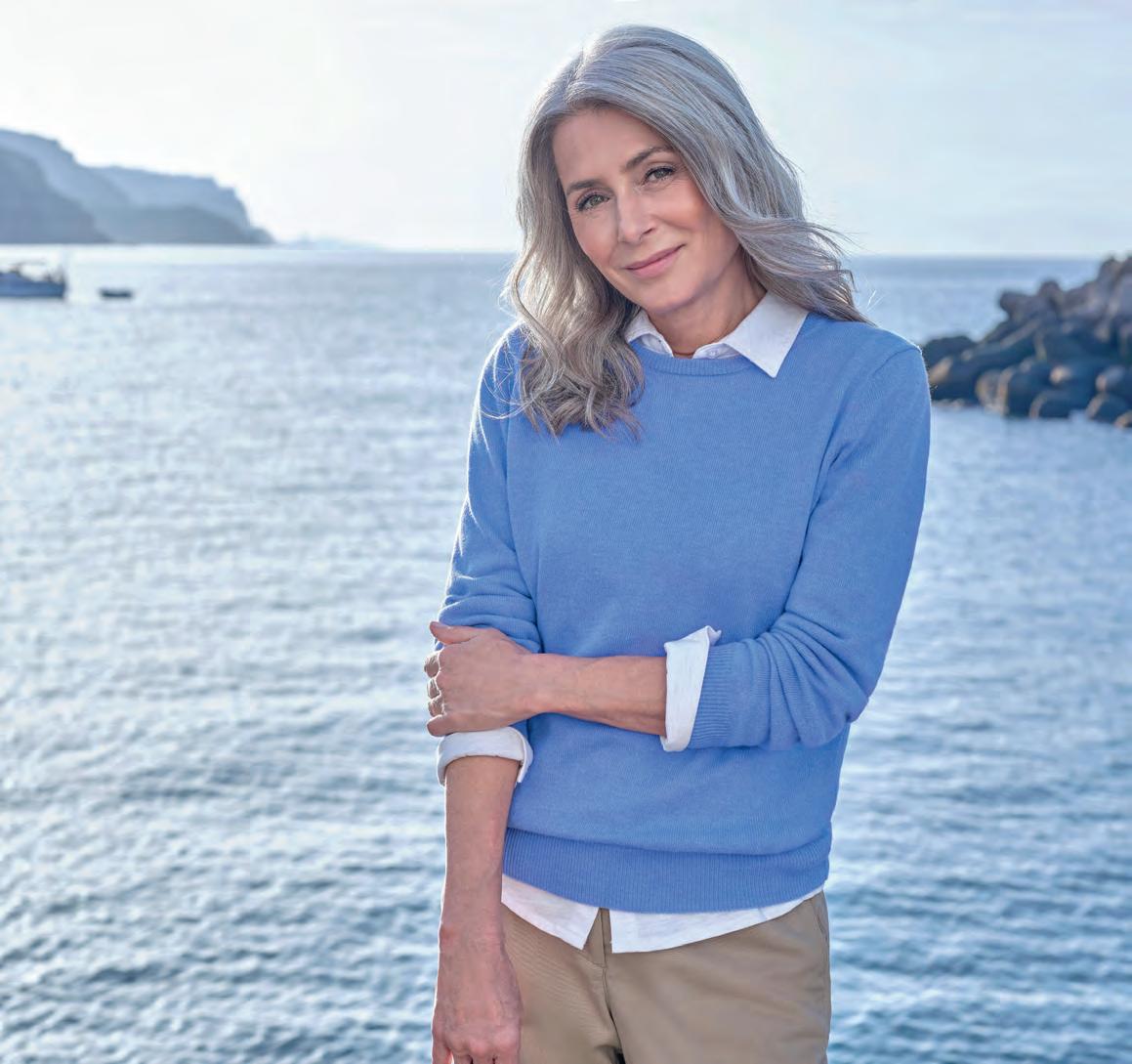













Relax and unwind in Slimbridge, the birthplace of modern conservation. Stay at Scott House Bewick’s Lodge for an unforgettable wildlife experience.


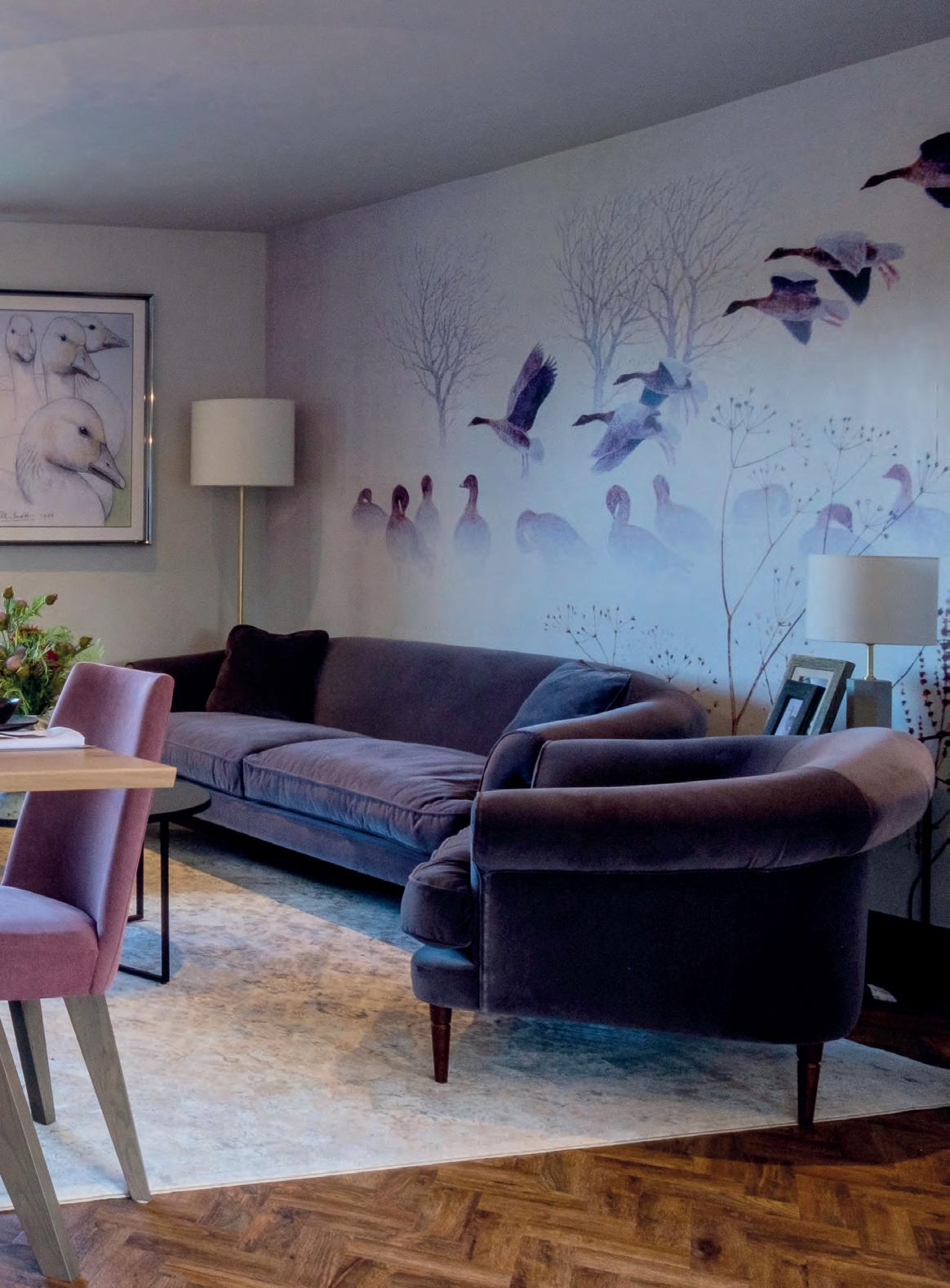
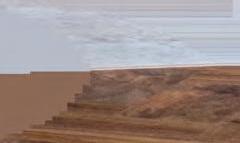

“Watery places seem to lend themselves to this kind of psychological loosening, and the height of spring is perhaps the most potent time”
In the thick fringe of reed by the lake, a reed warbler is cranking out sound as though life depended on it. For such a tiny bird, the volume, intensity and variety of song is astonishing. For a few minutes, this and every morning for the past few weeks, he has been the biggest presence at this particular spot.
Yes, there are geese and swans, herons and grebes, ducks and crows, foxes and deer. There is a cuckoo calling further away, skylarks overhead and some blackbird argy-bargy in the nearby wood – two of them flustered out of the bushes as I passed earlier, like brawlers tumbling through the swing doors of a Western saloon, seeming oblivious to my presence.
But this particular half-dome of air belongs emphatically to a tiny bird whose weight would be nothing in my hand. He has me captivated, though I’m probably not his type. His is not a melodious serenade, but it is impossible to ignore. He’s making maximum use of the dual output channels in the avian voice box to mix sweet trills and whistles among rattles and buzzes of radio-static crackle.
It’s more a kind of vocal breakdancing. He’s overlapping sounds so unpredictably that I find I can’t walk away… I might miss
something. Even across a species gulf, his ability to hold attention is remarkable. I settle against a tree, wrap a blanket around myself and close my eyes. He sings on for what might be a few minutes or a million years.
Birdwatching is poorly named. Sometimes I don’t want to watch – I just want to be present in their spheres of influence. Our sensory world is dominated by radiation and vibration, temperature and pressure, which is to say by the energy of things. We’re used to trying to make meaning of that energy, to filtering and interpreting. But it’s a powerful and transformative thing to try, now and then, to simply bathe in it. To receive without analysing.
Watery places seem to lend themselves to this kind of psychological loosening, and the height of spring is perhaps the most potent time. If you can, go early. Before dawn, before the birds are awake. I know it’s not always easy to crawl out from under the duvet, but I take my warmest clothes and something to sit on so I can drift into something like sleep out there. I think of it as a gift to myself, for which I know I’ll be grateful later.
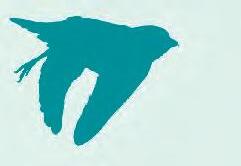
The best time to hear birds sing is on a spring morning, and many of our centres open early to make the most of the dawn chorus. Plan your next visit with our Get Closer pages (43-46) or go online to discover all the events you can join.

Dr Amy-Jane Beer is a biologist, writer, editor, outdoor enthusiast and mum from North Yorkshire.

We love to hear your thoughts about wetlands, WWT and Waterlife, and share your photos, so please email them to us at waterlife@wwt.org.uk or write to the address on page 4
We love this photo of marsh harriers over WWT Martin Mere in January by Michael Harvey. Thanks for sharing!
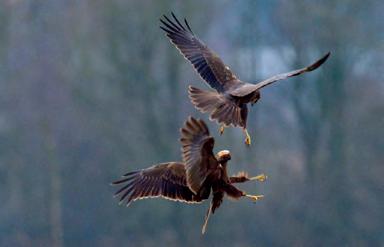
GREYLAG GEESE IN A FLAP
Itookthisimageof squabblinggreylag geeseatWWT Slimbridge,where Iamaregularvisitor. Iwastryingouta newcameraandwas quitepleasedwith theresults.
Dave PearceIvisitWWTArundelatleastonce aweek.Itwassoexcitingtosee thecattleegretsarrivelastsummer. Fromjustoneortwoatfirst, numbersincreasedtoover25.
Hazel Flack
WWT says: This small, white heron is an increasingly common sight as it spreads north to the UK from continental Europe.


SNAKES ALIVE! •
Icouldn’tbelievemyeyes whenIvisitedWWTLlanelli inOctober.Thesetwograss snakeswerecurledupontopof abramblebushjustbelowone ofthehides.Iwatchedthemfor agesuntiltheybothslithered off.There’salwayssomething differenttoseeatthereserve.
Beryl Wall

On a wonderful crisp day in March I was able to capture this captivating sight of a little egret having a particularly bad hair day. I had a great day visiting the various hides at WWT Slimbridge. Rob Dewey

•KING FOR THE DAY!
MysonReeceandI recentlyvisitedWWT Arundelandenjoyedour daysomuchwebecame members.Ahighlight wasgettingupcloseto kingfishers.Welovedthe boattripwherewesaw themflyingbackandforth.
Grant Fuller
I took this photo at the ottery at WWT Martin Mere. I wanted to get a shot where the otter was looking straight at the camera, baring his teeth. The two otters are usually together, so capturing one alone was a real bonus. William Blake
WIN! WIN! WIN!
Rob wins a copy of Where to Watch Birds in Britain by Simon Harrap and Nigel Redman, worth £25 and available in our shops and online.
We


We love to see your photographs taken at our centres. Please send your best shots to Waterlife and they could be published in a future issue. Just email your high-res images and a short story about what you photographed to waterlife@wwt.org.uk We can’t wait to see what you can do!


t/ Every dish is chosen for its quality and homemade taste
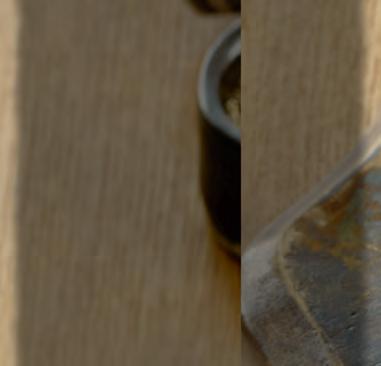
'
t/ Quick and easy to cook in the microwave or oven
t/ Flash-frozen to lock in goodness and flavour
t/ Easy ordering online or over the phone
t/ Delivered directly to your freezer by a local, friendly driver
t/ No subscriptions or contracts
t/ Over 40 million meals soldtry us today!


















Bufo
Our most widespread toad is recognisable by its bumpy, warty, greenish-brown skin, stubby back legs and copper-coloured eyes. In late winter, the common toad migrates from hibernation sites in undergrowth or woods to large, deep ponds where it breeds year after year. Here the female knits long strings of spawn around vegetation. The toads leave the pond shortly after to spend the summer in gardens or damp woodland.

See this species at Caerlaverock!

The natterjack’s key feature is the yellow stripe down its back. Unlike its cousin, this small, nocturnal toad runs. It can go fast in short bursts, though its short legs move in awkward steps, like a baby in nappies. Natterjacks are very rare and mostly coastal, found in shallow pools on sandy heaths, dune slacks and grazing marshes from south England to south-west Scotland. On warm evenings, the males rasp a chorus of croaks.
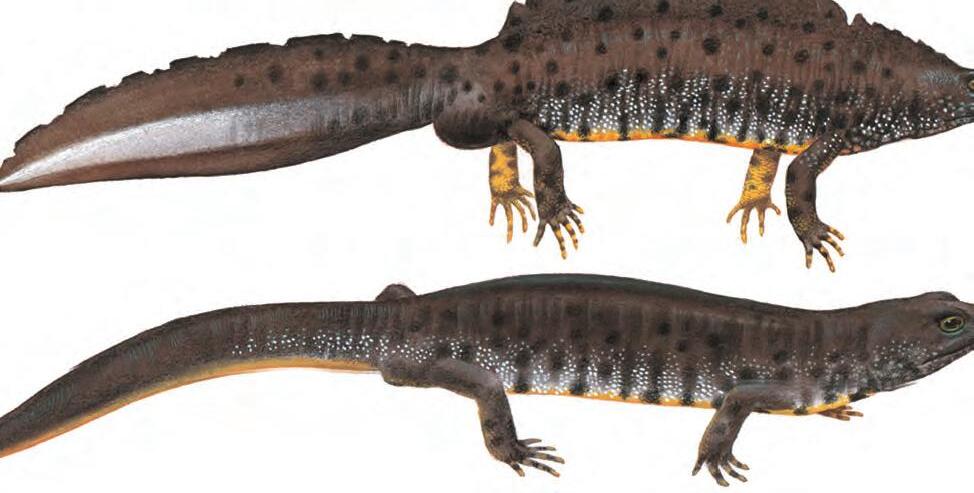

Triturus

The biggest of our newt species by far at 17cm, this is also called the warty newt because of its knobbly skin. The dark brown-black upper parts contrast with its yellow-orange belly, splashed with black spots. The breeding male’s crest is impressive – but notice how it ends at the base of the tail. A characteristic thin white stripe runs through the centre of the tail. Great crested newts are scarce, scattered in deep, open ponds with plenty of sunlight throughout lowland Britain.


Rana temporaria

Present in most habitats throughout Britain and Ireland from gardens to wetlands, the common frog is our best-known amphibian. The colours on its smooth body are variable, usually including a mix of olive green, brown and buff. It has a dark patch behind its eye and dark bands around its long back legs. The female lays floating rafts of spawn in early spring. In summer, frogs hop and jump away from ponds to damp places nearby.




Lissotriton vulgaris
Superficially similar to the great crested newt, with brown upper parts and a yellow-orange belly, this amphibian is appreciably smaller at 10cm long. And the male’s crest, grown for the breeding season, extends the full length of both body and tail without a visible break. This species is also called the common newt and with good reason – it’s found in ponds of all sizes, often coming into gardens. In early summer it leaves the pond and ranges widely in damp places.

There are three types of amphibian you can see in watery habitats in the British Isles – frogs, toads and newts. Some are native and others are introduced, but all of them make our ponds more exciting to discover. And if you’re really lucky, you might also spot one water-loving snake...


Pelophylax lessonae




Pelophylax ridibundus
About the size of a common frog, the northern pool frog was thought to be extinct by the mid-1990s. It has been reintroduced, mainly to parts of East Anglia and south-east England. Dark green or greenish-brown with black blotches and a cream or yellow stripe down its back, it has yellow marbling on its thighs. Pool frogs prefer shallow, weedy pools and breed in May or June, the male inflating white vocal sacs to give loud croaks.



PALMATE NEWT
Lissotriton helveticus
Sometimes confused with the smooth newt, this species is most often found in shallow pools on acidic heaths and moors. Though it also has a brown body and yellow-orange belly with black spots, it lacks spots on its pink or yellow throat. During the breeding season, the palmate male grows black webbing between its hind feet and a thin spear-like filament at the tip of its tail.
Europe’s largest frog (a magnificent 15cm long) is not native to the UK but is widespread, concentrated especially in southern England, thanks to releases that began in Kent in the 1930s. It is almost always found in water or very close by. The marsh frog’s warty skin is either olive or bright green with black spots, and it has a ridge running down its back that begins just behind the eye.
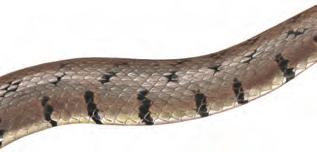
GRASS SNAKE
Natrix helvetica
Growing to more than a metre, this is the longest of Britain’s three snake species, and is harmless to humans. Shy and elusive, it’s found in wetlands and grasslands across England and Wales. It has a grey-green body, pale belly with black bars down the sides, and a yellow and black collar. Grass snakes are most often seen hunting in ponds for fish and amphibians or basking in the sun.
EDIBLE FROG
Pelophylax esculentus
It’s no surprise that the edible frog is very similar to the marsh and pool frog since it’s a fertile hybrid of the two species. It is green or olive with dark-brown spots and sometimes has a yellow stripe down its back. In the breeding season males may turn much lighter green. The name of this largely aquatic species derives from the fact that its legs are considered a culinary delicacy in France. It is also popular with herons and grass snakes.

These beautiful illustrations by Denys Ovenden are taken from the Collins Pocket Guide to Freshwater Life: Britain and Northern Europe, the ideal freshwater companion and ID guide published by Collins (RRP £20). Available to buy online and from all good bookshops.
Learn more about amphibians at wwt. org.uk/amphibians
Find out how you can get closer to nature on page 43

Looking back at WWT’s achievements fills us with hope. There are challenges ahead, but with them come exciting opportunities to make real progress. Sarah Fowler, Chief Executive, introduces four wetland champions who are supporting us on our journey…
We know better than anyone that incredible things happen where land and water meet. Wetlands are the lifeblood of the planet, but we’re losing them at a terrifying rate. There’s no doubt we’re facing a time of huge challenges and huge opportunities. The world is waking up to the power of wetlands to help solve environmental, climate and social problems, and WWT must seize the chance to use our voice, expertise and skills to drive positive change.
At our AGM last year, I reflected on the four main challenges faced by WWT and nature conservation in general. They are the global loss of biodiversity, and wetlands in particular, rising global temperatures, an incessant drive for economic growth without nature (or societal health) at its heart, and a lack of awareness of what wetlands are and what they offer us. In this issue of Waterlife, I have invited four wetland champions to share their personal views on, and experience of, these challenges.
WWT has big ideas and hopes for the years ahead. We’ve already set an ambition to restore 100,000ha of wetland in the UK, and hopefully we can achieve even greater things on action for wetlands. My dream is to see people take action to restore wetlands, from local action to it being at the heart of public policy, and there are three ways I’d like to see this happen.
First, wetlands need to be part of conversations when planning new infrastructure. Wetlands can reduce flooding, purify water and are great to live
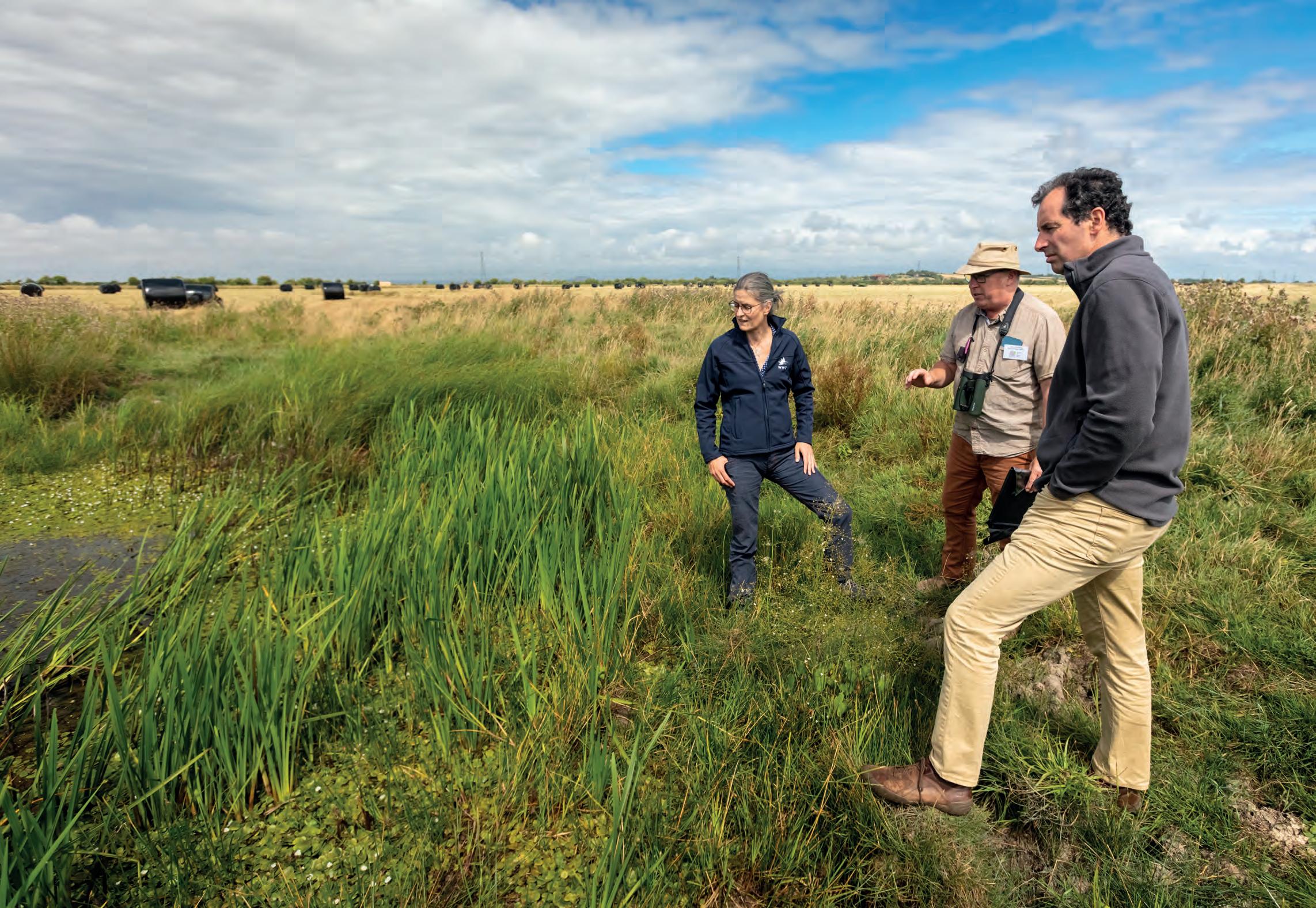
and work beside, so would it be too much to ask that when, for example, new urban areas are planned, the architects, planners and funders plan in blue infrastructure from the get go, and not just grey infrastructure?
My second hope might surprise some of you, but I would love wetlands to be recognised as a tool in the armoury to solving some of our social, health and humanitarian problems. Restoring nature-rich wetlands can build back resilience for communities to problems of water security, flooding, food security, declining wellbeing and increasing temperatures. We need big ideas and big solutions, and the power of wetlands is too often underestimated.
Lastly, biodiversity loss is now so urgent its recovery needs to move up the agenda. What if nature’s decline was considered as seriously as war and conflicts? While the impact of nature being in free fall may occur in slow time for now, the effects of not taking action will be huge. We invest enormous effort in responding to conflicts. We should treat nature’s decline with the same sense of jeopardy. And the best way to help nature recover is to add water and see how quickly it bounces back.
WWT is courageous. We have hope. Now is the time to make the changes in the world we want to see. But we can’t do it alone – we need you. We need the world to wake up to the power of nature-rich wetlands, and you can help. Please speak up for wetlands and help other people fall in love with them.
SARAH FOWLER, WWT Chief Executive

Sarah has been busy meeting WWT’s wonderful partners – from volunteers to the group of leading organisations working with us to create networks of healthy wetlands across the UK
CHALLENGE: Increasing public understanding of wetlands
CHAMPION: Mike Dilger, ecologist, natural history presenter and WWT Vice President
I was shocked when a recent study found that 45% of people don’t know what a wetland is. They obviously don’t realise that to make a wetland you ‘just add water’! I’m sure everyone knows what that is.
My home is 15m from a pond, 40m from a stream and 400m from a reservoir. Most people live close to some type of wet habitat. They might not realise that a damp area of grass, a puddle or even a cattle trough can provide a habitat for wildlife. Almost everybody has a pond close by, wherever they live, perhaps even in their own garden.
We shouldn’t underestimate the power of ponds and other mini wetlands. From a conservation perspective, our gardens are incredibly important for nature. I love admiring the hive of life in our pond with my young son. As a child, my own love of nature was triggered when I became entranced by big, powerful dragonflies.
There are many challenges in making people aware of the wet stuff. Recently, I spent a year trying to see 1,000 species of plants, and one of the things that saddened me was how often I was completely alone on a gorgeous nature reserve, often a wetland. We need to get people to these places. If they don’t know how amazing they are, they won’t visit and they won’t care about them if – when! – they are threatened.
We need people to know how good wetlands are for people’s mental health. Obviously, it’s great to walk anywhere in nature, but wetlands are particularly restorative. Just think of the serene beauty of a lake or the wonderful feeling of contemplating a river or stream flow past. I’m fortunate enough to be able to walk our dog by a large reservoir every day, and just hearing all of nature’s sounds makes me feel lucky to be alive.
Kids love water – they simply cannot resist splashing in puddles. And puddles, we know, are mini wetlands. That’s where it all starts.





CHALLENGE: The loss of wetlands
CHAMPION: Tony Juniper, Chair of Natural England and Chair of our Blue Recovery Leaders Group
In the UK, the loss of wetlands has been so devastating we don’t have much left to lose. Over the past 300 years, 75% of wetlands have been lost from the UK, so even though the net rate of loss has greatly reduced in recent years, we’re starting from a critically low level.
It’s ironic that the world is only now finally recognising that wetlands are essential for life and are not wastelands. Environmental economists have been talking about the value of wetlands since the 1980s, highlighting how they reduce the risk of flood and are among nature’s best carbon sinks, storing large amounts of carbon in the soil. It has taken 40 years for this knowledge
to become mainstream enough to start informing public policy and opinion.
There are signs the environmental tanker is turning. Public opinion favours nature protection and most politicians grasp this, so I think we can allow ourselves some optimism. Optimism is harder work than pessimism and demands that we envisage a future that doesn’t yet exist. For nature to recover, we need to adopt a broader approach and a landscape scale. The challenge will be to bring multiple stakeholders together in working partnerships, both in the public and private sectors.
Change is already happening. Natural England aims to restore 35,000ha of degraded peatlands by 2025, for example, and the Blue
Recovery Leaders Group, which includes water companies and housing corporations, is an inspiring example of what can be achieved. Everyone can do their bit by encouraging their elected representatives to get on board with nature recovery, and by sharing their priorities with partners such as water companies (of which they are customers) and others in the private sector.
Globally the situation is more challenging. Wetlands are disappearing three times faster than rainforests, and large, wildlife-rich wetlands, such as the Pantanal in Brazil, parts of the Congo Basin and peat swamps in Sumatra, are being decimated. Finding a balance between competing demands will not be easy.
“Optimism demands we envisage a future that doesn’t yet exist. For nature to recover, we need to adopt a broader approach and a landscape scale”
CHALLENGE: Empowering young people
CHAMPION: Lucy Hodson AKA Lucy Lapwing, naturalist, conservationist and WWT Ambassador
When I started writing and posting wildlife on Instagram at the age of 22, the ‘culture’ of wildlife and conservation felt alien to me. It was a subject treated seriously by those involved, and seemed like there was little room for silliness and informality. I was just a ‘normal’ person with an interest in wildlife – I’d go to the pub with mates every weekend, yet I was becoming more and more passionate about the natural world.
I think people outside the world of conservation perceive nature lovers as serious and a bit dry, but it doesn’t need to be like that. My antidote is to be enthusiastic and even a little ridiculous in my nature communication – be it on YouTube or Instagram. By introducing a degree of informality and a lighter, more accessible approach, I hope to help bridge the gap between us ‘nature nerds’ and younger people who might be curious about wildlife.
My grandparents spent much of their lives outdoors, yet our cultural separation from nature had already begun long before them. It’s deeply engrained and multigenerational, and it leads to young people having little or no connection to the natural world – for instance, many people in the UK
today have never heard a cuckoo’s call. Without that emotional connection to a species, or a wild space, they won’t care what happens to it. But on the other hand, if they do experience a wonderful wildlife moment, it can be transformational.
Many of the young people I talk to are convinced the root of this disconnection lies in societal change and upheaval. For example, land justice (patterns of unequal access to land) and the right to roam have a huge impact on people’s opportunities to enjoy the countryside. I think we have an opportunity to create a different future. Developing a slower relationship with the land, lessening our consumption and appreciating the life in the land around us.
In the fight against the biodiversity crisis some of the most powerful tools we’ve got are positive ones. Passion, enthusiasm, love and kindness – they sound cliché, but they work. I look forward to spreading the love, especially about special places like wetlands, and hopefully exciting new and young audiences about the wildlife living in them.
“I think people outside the world of conservation perceive nature lovers as serious and a bit dry, but it doesn’t need to be like that”


CHALLENGE: Forging partnerships for change
CHAMPION: Lord Deben, Chair of the UK’s independent Climate Change Committee
Fundamentally, I don’t see a conflict between economic growth and tackling the problem of the reduction of biodiversity around the world. It is vital we tackle it for our own good, not just economic but also in terms of health and other aspects of wellbeing.
The world is sick and climate change is the symptom. But we need to treat the disease itself, which includes the destruction of biodiversity. The earth is calling out for healing. I don’t think everybody understands the link between biodiversity loss and climate change; it must be taken more seriously.
I own a farm and have been working to improve it for the past 20 years, such as restoring the hedgerows, stopping growing wheat and using natural fertilisers – cattle.
I have two pieces of advice for WWT members to help make a difference. Firstly, don’t allow two months to go by without visiting your local MP’s surgery, or contacting them directly, to say how you feel about these matters. MPs tend to listen more to personal forms of communication from their constituents.
Secondly, do your homework and get to know in detail about these issues, particularly as they apply in your own community. Then talk to friends and neighbours. This will make a big difference.
Talk in the community has a knock-on effect on local commercial businesses. The people running them need to be informed about local issues and persuaded that there is a moral issue in preserving and enhancing biodiversity. Let them know that their willingness to take it seriously will have strong reputational repercussions. n



“When despair for the world grows in me… I go and lie down where the wood drake rests in his beauty on the water, and the great heron feeds. I come into the peace of wild things.”
I love that verse from Wendell Berry. “I come into the peace of wild things.” Such a simple phrase but it’s quite counter to our culture that wild things, wild places, are peaceful. But they are in my experience.
Wetlands have given me such joy and inspiration over the past few years, and if you’re like me, it’s easy to feel so powerless in the face of governments and big corporations. But you can help WWT in their wonderful and inspiring work.
“I don’t think everybody understands the link between biodiversity loss and climate change; it must be taken more seriously”
It’s time to speak up for our amazing wetlands and their wildlife, and to campaign for more of these vital habitats. Join our Wetlands Can! campaign at wwt.org.uk/wetlands-can and add your voice to the 14,000 people calling for 100,000ha of new healthy wetlands to be created in the UK for the planet, for wildlife and for people.

Nature is amazing and, thanks to the skill and patience of WWT members, the stunning winners of our annual photo contest help open our eyes to the beauty and drama of life around our reserves
This year, we were spoilt for choice with the variety of beautiful, fascinating and surprising images of nature submitted to our annual photo competition. From birds in flight to birds of prey, and from new life to near death, the photos revealed our entrants’ remarkable dedication, incredible camera skills and
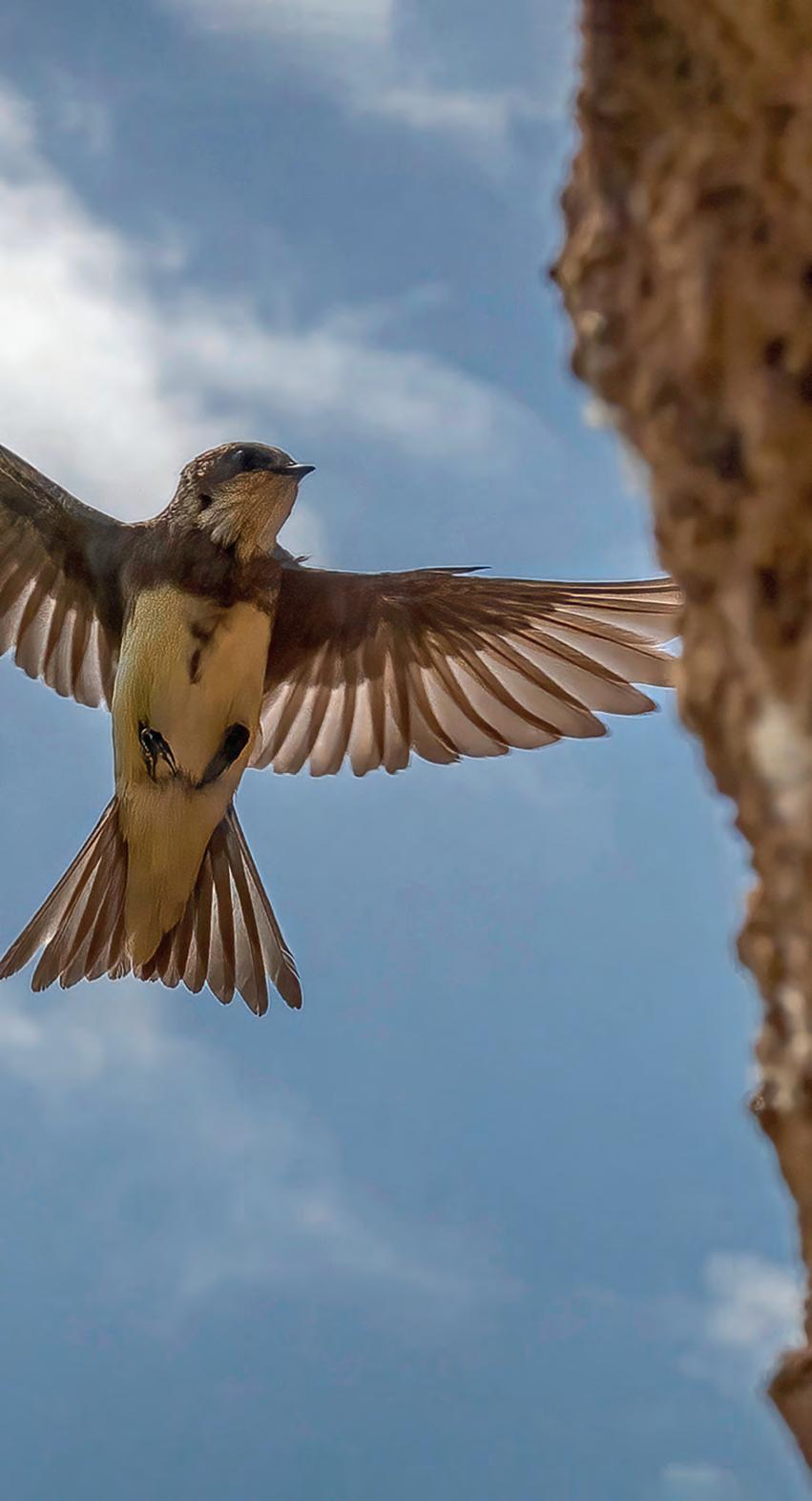
extraordinary creativity. Through their lenses, we are allowed to witness moments that are truly magical, yet rarely seen.
It was hard to select the shortlisted images for these pages and our website. Congratulations to all our finalists, particularly Chris Bishop who wins a pair of Swarovski CL Companion 8x30 binoculars for this uplifting image of WWT Arundel’s


Chris says: “This photo of two sand martins returning to their nests was taken last June at the Sand Martin Hide.
That summer, there were many successful nests, and multiple holes being used. This gave visitors great views of the birds coming and going, darting around at speed, performing acrobatics and flying in formation. This was my favourite shot as it captured two of these glorious birds, just the other side of the glass of the window.”
The jury says: “It’s hard to photograph hirundines in flight – they’re so quick!
But Chris has captured a lovely moment when these two sand martins returned to feed their young with crops full of insects.
Exposing for the bright sky, he’s captured their dynamism and gorgeous feathers while maintaining great separation between the two birds. Just wow!”
sand martins. We’re excited to follow the journey of the winner of our young photographer category, Christina Kirkby, who impressed the jury with her beautifully observed sleeping waterbirds. Christina wins a pair of Viking Otter 8x32 binoculars. Huge thanks to Swarovski Optik and VIKING OPTICAL for sponsoring our competition prizes. n
Keith says: ”To capture this image of a mallard stretching its wings last summer, I positioned myself at water level to create a more dramatic image.”
The jury says: ”In all the wingflapping, spray-making drama of this action photo, Keith has concentrated on the eye of his subject, which is compelling in its stillness. Like an exquisite cape, the purple-blazoned wing has a lovely tension and great feather detail. The colour is well balanced and the dark, diffuse background highlights the flying water perfectly.”
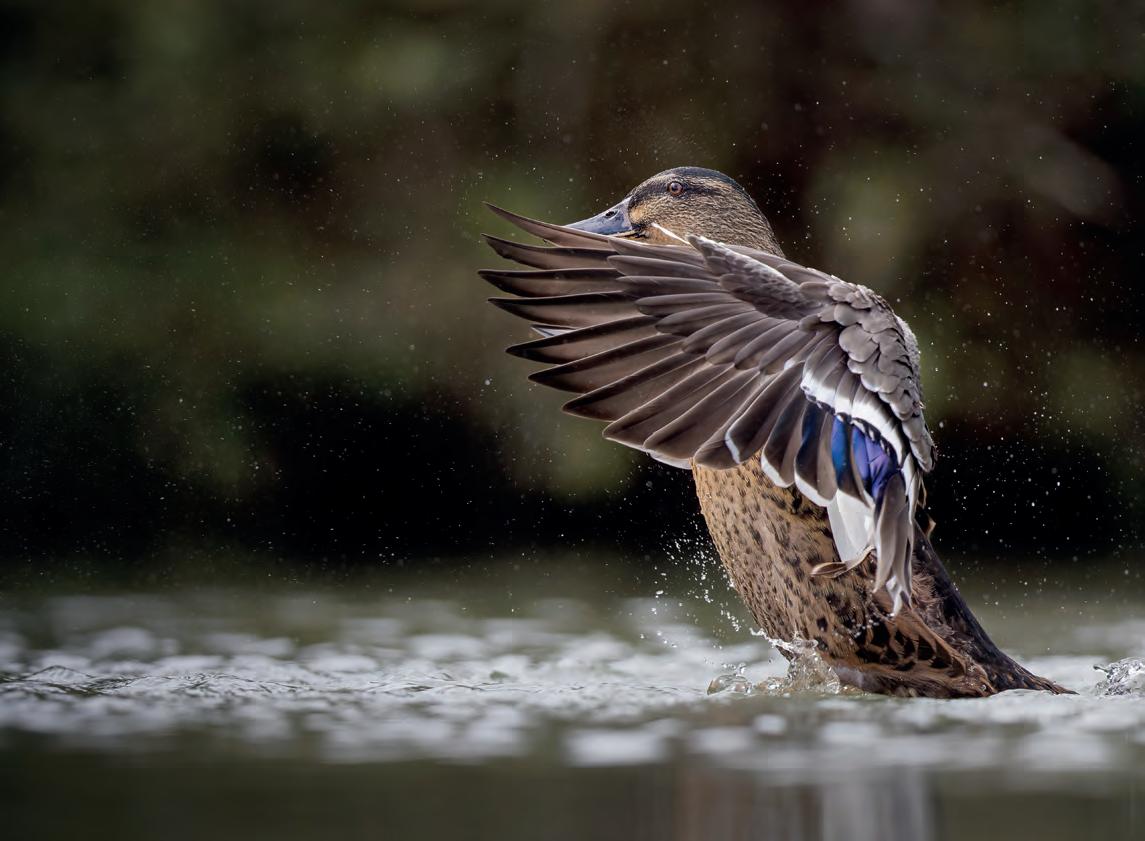
Jonathan says: ”From the Kingfisher Hide I could hear reed buntings singing in the reeds. They swayed in the wind, so I used a high shutter speed and a long lens to make sure the bird was sharp.”
The jury says: ”The colour palette and composition of this portrait are sublime. Like painterly strokes of a brush, the reeds part to reveal their secret – a female reed bunting. From the tip of her beak to her tiny toes, she is rendered in exquisite detail.”




Alan says: ”Last summer, I was at the dipping platform when I heard a ‘plop’. Turning, I was amazed to see this creature
looking at me from the water. I knew the moment would last only seconds – sure enough, after a few frames it had gone. As I didn’t see the tail I don’t know if it’s a weasel or a stoat. The ability of both
species to swim illustrates the risks from predation for young wetland birds.” The jury says: ”Occasionally a photographer shows us something we’ve never seen before, and Alan has done
Christina says: “Taken at the raised pond in July, this emperor dragonfly was busy laying her eggs while keeping an eye on a potential predator nearby – a robin. It made me realise how vulnerable dragonflies are while they are laying their eggs.”
The jury says: “Christina has captured one of the fastest animals in the air during a quiet and sensitive moment. The low camera angle reveals the specialised anatomy of this aerial acrobat, while the delicate light on the water and the dark, diffuse background make her subject stand out perfectly.”
just that. Due to his lightning reflexes and instinctive camera control, he caught this rare and special moment, highlighting the versatility and courage that make these species so successful.”




See more of our favourite shots from this year’s contest at waterlifephotowwt.org.uk/

Christina says: “When I saw these two wandering whistling ducks sleeping together, I realised it was the perfect opportunity for a photo.”
Thejurysays: “What we really liked about Christina’s portfolio was that she had identified and explored a theme – sleeping birds. This cleanly composed image reveals a quiet, intimate moment few people would notice, and we commend Christina on not waking her sleepy subjects. Shhhhh!”
The jury would like to commend the entries of Charlie Allen and Katie Shepherd, who also wowed the judges. Buy Viking and Swarovski Optics with WWT and give back to wetland nature with each purchase – search ‘WWT optics’ online.
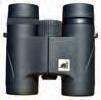
Garry says: ”I was in the Ron Barker Hide in July when suddenly all the birds at the back of the marsh took off. I scanned the sky to see the cause of their alarm when, moments later, a sparrowhawk emerged from the commotion, clutching a bird in its talons and flew directly over the hide.”
The jury says: ”Garry must have lightning reflexes and an amazing ability to stay cool under pressure. Sparrowhawks are so fast and so unexpected in this environment, yet Garry has focused on the fierce yellow eye of this efficient predator and composed a spectacular image.”
Emma says: ”This photo was taken in August at the flamingo lagoon. These quarrelsome flamingos jutted their heads out aggressively at each other and puffed up their back feathers. This performance displayed their vibrant colouration and impressive long necks. The dispute only lasted a few seconds and, after this picture was taken, they went back to peacefully standing on one leg next to each other.” The jury says: ”Emma has perfectly captured the intensity of this interaction, and the texture of the birds’ flamboyant feathers. The frame is well balanced and the dark backdrop, limited palette and stillness of the rest of the flock provide the perfect foil for her subjects.”
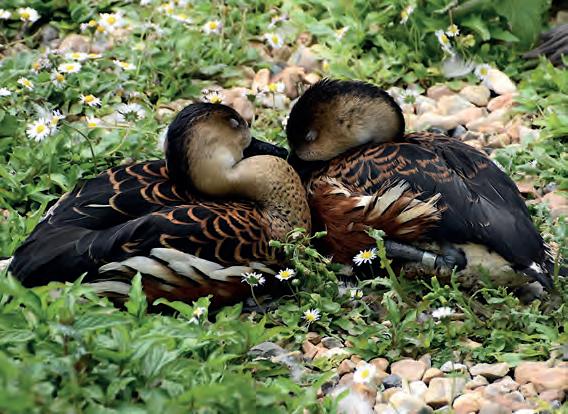

Currentcatalogueprice £39
Specialintroductory price£29 - saving£1O and FREEP&P
Diamondquilted style with zip front and cordedshoulders.Fullylined in soft fleece, this lightly paddedbodywarmeroffersextra warmthand comfort.Studdedfront patch pocketswith both top and side entry and side backvents.100%polyester. Gentlemachinewash.
SizesM (42") L (44") XL(50") XXL(54") 3XL(59")
7B4 GR £39 £29 Postage& packing £558 FREE
Orderingand delivery
Forcredit and debit cardorders
Phone0333 241 4468 (we are here Monday-Friday9am-6pm, Saturday9am-5pm)
Orderonline
www.jamesmeade.com or completeand return the couponalongside. Offerends16thMay2023.
Allow7 daysfor delivery.
(Current

We know ponds are one of the best ways of bringing more wildlife into an area. Now, a new study is exploring how much ponds enhance productivity in the surrounding landscape
Last year, strange things were going on in ponds on a farm in Gloucestershire. Scientists were dripping something into the water. “We squirt very small amounts of a salt containing Nitrogen-15, diluted in water, around the pond perimeter,” explains Dr Sarah Davies, a WWT Senior Research Officer based at Slimbridge. This apparently simple act might not sound important, but it could reveal why ponds should be a greater part of conservation science in the future.
Nitrogen-15 is a stable isotope found rarely in nature alongside the abundantly occurring N-14. Though heavier, it reacts the same way and forms the same compounds as N-14, so it can be introduced artificially into an ecosystem. Importantly, since N-15 is only ever added to the environment in very low concentrations, it causes no harm to pond life.
“We follow the N-15 and see how far it travels up the food chain,” says Sarah. “We would expect it to be taken up first by aquatic flora, such as algae and pondweeds. Then this vegetation is eaten by animals such as aquatic insect larvae. Once they transform into adults and leave the pond they are, in turn, eaten by wildlife outside the pond.”
The significant part is that the N-15 can be subsequently detected, in theory, in any plant or animal tissues, simply by collecting organic matter in the locality and sending it to a laboratory to be tested in a mass
spectrometer. It could, for example, be found in the feathers of a bird that ate an insect that had consumed algae in the pond.
Many pond insects spend their early life stages underwater, but eventually emerge as winged adults and disperse into the surrounding habitat. These emerging insects are an important food source for birds and bats, and an example of an ‘aquatic subsidy’ – energy and matter that is transferred from aquatic to terrestrial habitats.
“So far, very little isotopic labelling has been done for ponds,” says Sarah. “So we’re trialling this approach to see if it might, one day, be possible to trace the journey of pond insects into the wider landscape. This would help us determine the ‘reach’ of this subsidy and measure how much they benefit the wildlife that feeds on them.”
While this might seem an easy enough concept to understand, in practice it is extremely difficult to get definitive results. “People don’t always realise that science is messy, and a great deal of practical work goes into making even small steps,” says Sarah. “It takes many samples over a long time to get an idea of what a pond truly contributes to an area.” It is perhaps like a jigsaw with many thousands of pieces.
“We have begun by looking for our N-15 label in a small sample of insects leaving the pond (the adult stages of the larvae that have hopefully taken up the N-15),” she says. “Certain mayfly nymphs
“We are trialling this approach to see if it might one day be possible to trace the journey of pond insects into the wider landscape”

feed on algae, and non-biting midge larvae often do the same. Adult midges are particularly important prey for songbirds.”
So far the team has conducted a pilot study to add a small but traceable amount of the label. They have been able to drip the label into four ponds, each of a different size

We analyse water quality to test the health of the four farm ponds

There are many different isotopes of different elements in nature. Every place in the world has its own signature, and isotopes can be used in archaeology and palaeontology, among many other applications.

and profile. There is preliminary evidence that pond insects from this study, especially the mayflies and non-biting midges, show measurable N-15 enrichment, which means that this pioneering work is going in the right direction.
“We will also test some pondside predators,” says Sarah. “Last summer, we used pitfall traps (holes dug into the ground with a collection chamber) to catch mobile hunters such as ground beetles and spiders. The next step is to see whether they are eating any labelled food from the ponds.
“Because they take all sorts of prey, not just pond creatures, we will probably find a lot less of the N-15 label in these predators. But even just a bit of enrichment suggests they are eating some pond insects.”
Sarah’s work is a classic example of the sort of real-life science WWT is involved in. It’s under the radar, yet full of successes and learning opportunities. However, in a few years’ time, we are very likely to be hearing a great deal more about isotopic labelling. n

The scientists identified ponds to which they could agree access with landowners. The ponds were assessed to see whether they were suitable for the label – not too big or liable to dry out, for example. Then water samples were collected for analysis in WWT’s wetland science laboratory, to ensure the water in the ponds was of high-enough quality to harbour healthy invertebrate populations.

The animals
In order to detect the N-15 percolating into the ecosystem, the researchers used floating emergence traps to catch adult mayflies and midges. After this, they dug pitfall traps into the ground around the edges of two of the ponds in order to catch predatory beetles and wolf spiders, which are potential secondary inheritors of the label.

The
For this study, the team worked for three months at the ponds, starting in May 2022. Owing to this being an experimental plot, they applied small amounts of the N-15enriched ammonium chloride once a week into two of the ponds, building it up slowly. In the other two ponds they put in the complete dose at the start. This variation was to test which was more effective, and help to fine-tune the technique in future.

Results must always be compared with controls, so the team caught invertebrate larvae before the N-15 label was applied to test for naturally occurring background levels of N-15. The specimens were sent to labs for stable isotope analysis. In future, this could be extended to testing bird feathers and bat droppings, insectivores that are likely to have been feeding near ponds.



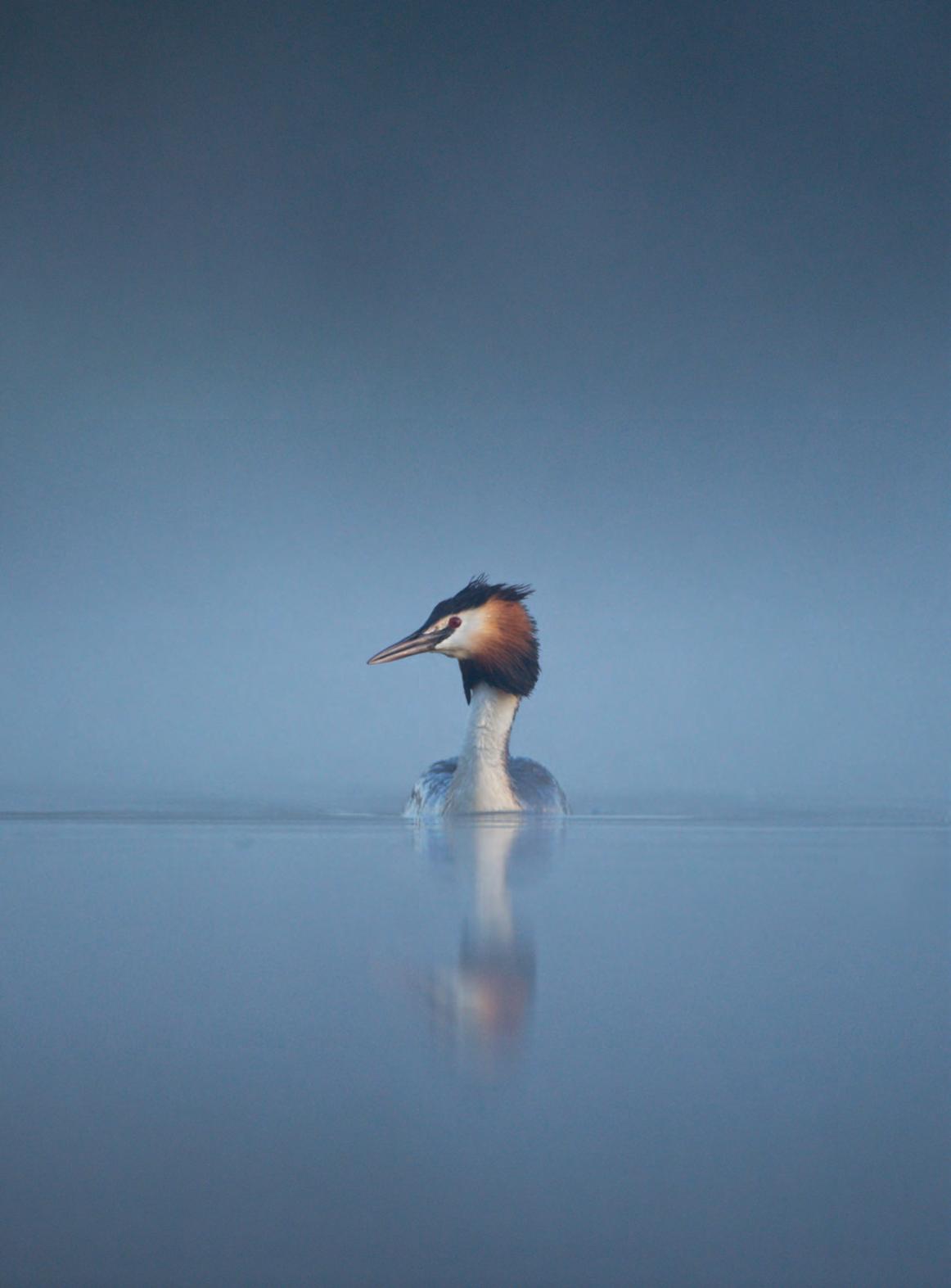
IN SPRING, HEAD TO THE WATER’S EDGE TO WITNESS A NATURAL PERFORMANCE LIKE NO OTHER – THE GREAT CRESTED GREBE’S COURTSHIP DANCE
BY ANDY PARKINSONAll photos by Andy Parkinson
An adult grebe, the epitome of elegance, emerges from the cool, pre-dawn blues of a mist-shrouded lake. Timing is everything and as the grebe glides towards my hiding place, I resist the temptation to press the shutter. I’ve worked in these conditions long enough to know when the time is right. Too early and the grebe will be rendered a murky outline, lost in a sea of fog. Instead, I wait patiently for the moment when the grebe breaks free of its misty shroud and reveals its exquisite beauty.

Few natural spectacles in the UK can compete with two great crested grebes performing their elaborate courtship ritual. A series of synchronised movements –head shaking, bill dipping and preening –culminate in the ‘penguin’ or ‘weed dance’, where the two birds seize some vegetation to swish and then rise, breast to breast, treading water. Here, as the last rays of late evening illuminate a courting pair, the translucency of their bills becomes apparent. A distant forest in shadow creates a dark backdrop that enables me to reveal the subtle caress of our stars’ dimming light. Time spent in the grebes’ company in March is time well spent, as this is when their romantic display is at its peak.


A grebe erupts into a territorial fury, wings outstretched, startling red eyes locked on the subject of its ire. Such pursuits can be brief but they are often aggressive, and fights do occasionally break out. In such moments I always try to shoot flexibly, being ready for any action and aiming for a high shutter speed to freeze the explosive moment. Working at water level can create a feeling of intimacy, but protect yourself and your equipment from the water.
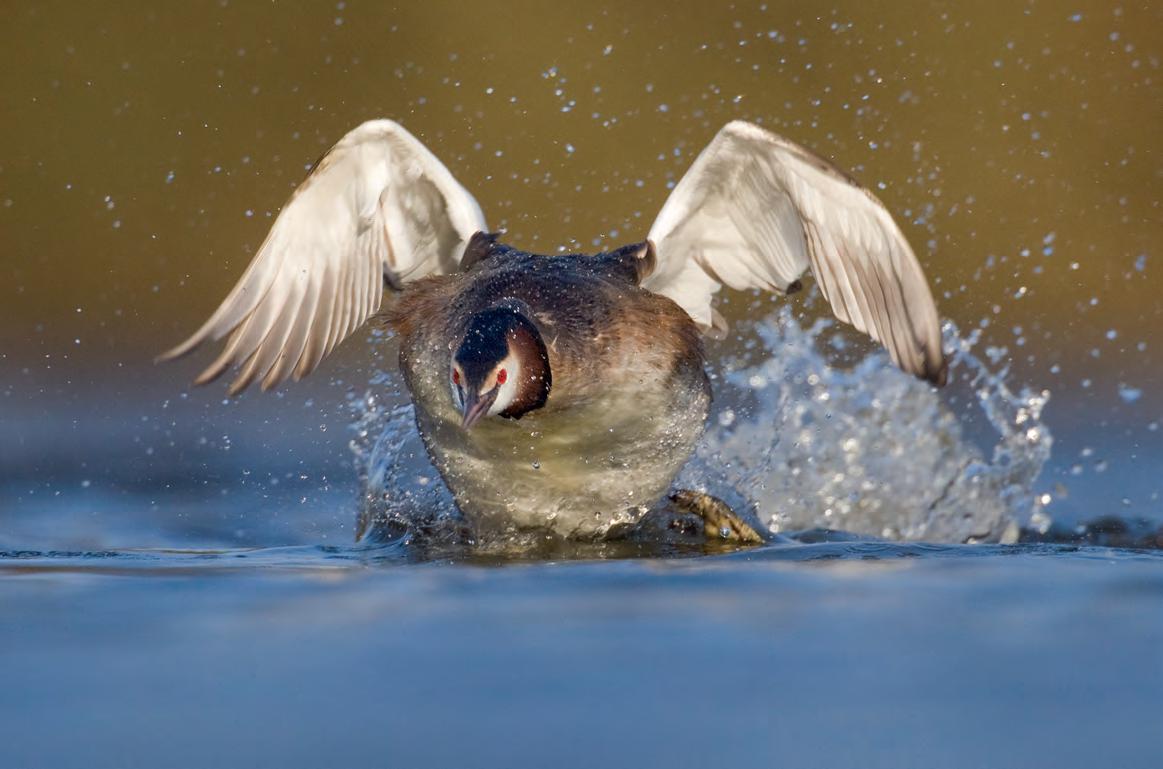
A lucky moment for the grebe – and for me – but, sadly, not for the poor fish. The grebe did not expect to see me when he surfaced with his prize, hence his look of surprise, and his low-slung body position told me he was about to dive. There was no time for me to do anything other than press the shutter. The water droplet is serendipitous, but this encounter, like so many, was simply pure luck. As always, the old adage rings true –‘the harder I work, the luckier I get’. In wildlife photography this is especially true!

ANDY PARKINSON
is one of Europe’s leading photographers and a Nikon Europe Ambassador (Wildlife). His work has been published in National Geographic and many other magazines.
We love to see the photos you’ve taken at your local WWT centre. If you’ve been inspired by Andy’s grebes, why not see if you can capture their behaviour on your next visit? The best images will be published in our Your views section. Send them to waterlife@wwt.org.uk


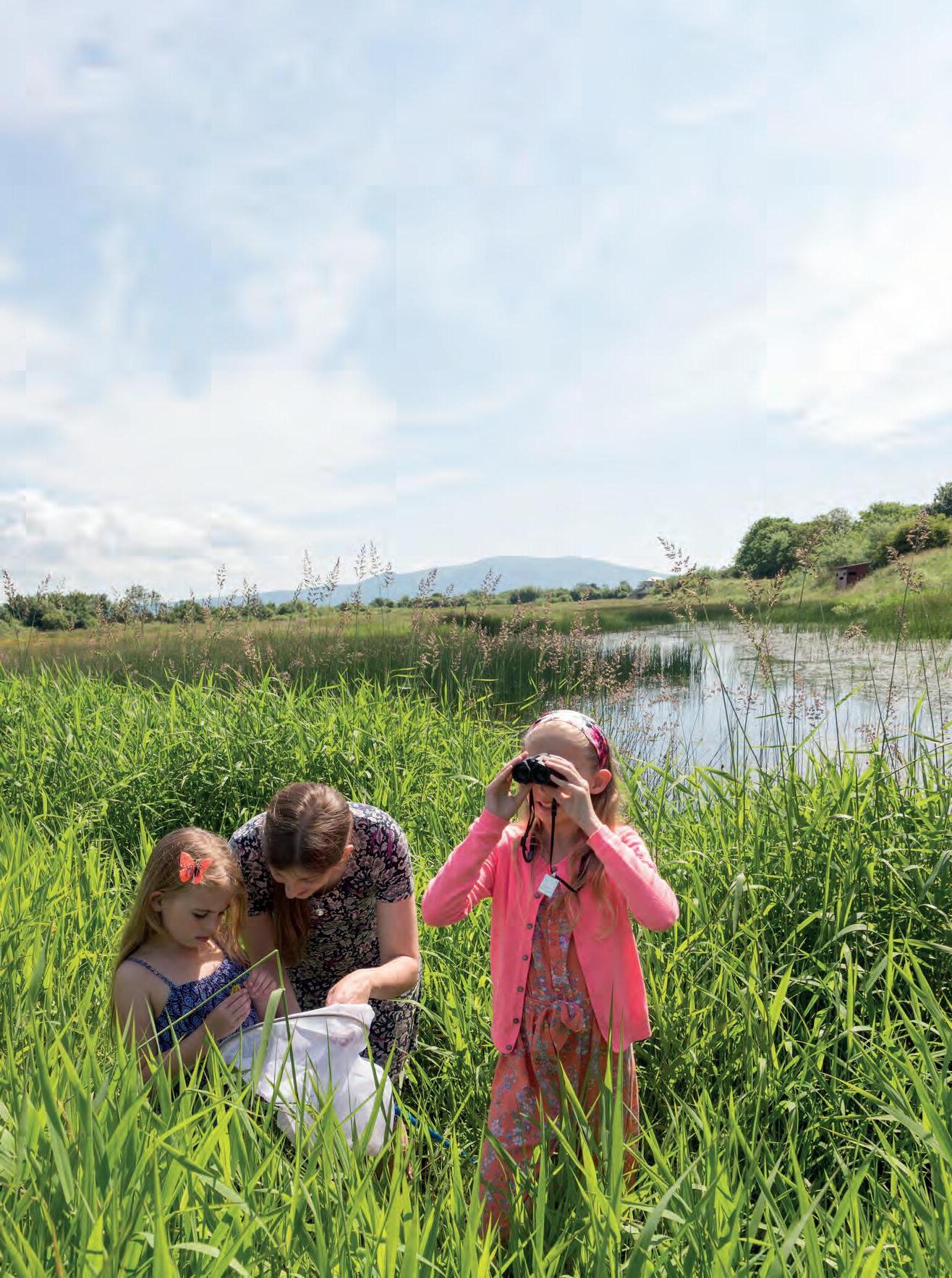







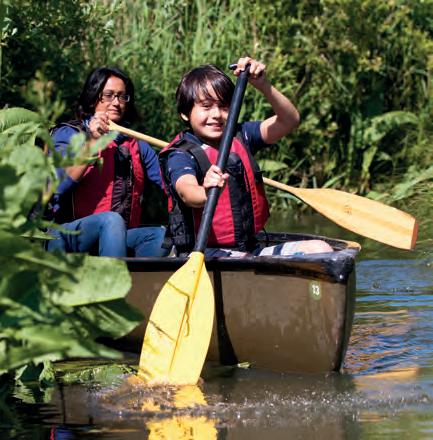

Have a quacking time at WWT Martin Mere this Easter holidays with our Easter duck trail. Get outdoors with all the family as you search high and low for all 25 GIANT ducks! Discover more about real-life ducks as you explore and get a tasty treat at the end. There’s so much to do together this Easter, from arts and crafts to otter feeds and pond dipping. WHERE: MARTIN MERE

Fill up your senses and experience our wonderful wetland wildlife from the water this spring.
From April to October, WWT Slimbridge offers magical Canoe Safaris. Paddle through reedbeds, under overhanging trees and past vibrant flowers – which route will you explore? Enjoy being immersed in wildlife, from dragonflies zipping by the boat to reed warblers singing from the reeds, and all our duck and geese families with their new young learning to swim. Canoes are £10 each and seat up to three people per boat.
On 24-25 June, bring your magnifying glass and discover the little things that run the world on land, in the water and in the air... Insects! Join our family pond-dipping sessions, swish a net to catch insects, spot dragonflies from a boat and settle in for insect storytime. Collect our insect spotter sheets or join a free craft session to build a mini bug hotel.
WHERE: ARUNDEL
You can also pick up a paddle and discover WWT Martin Mere’s awardwinning Canadian canoe trail from April to September. Explore a part of the reserve not accessible by foot in a canoe or on a guided boat tour.
With bobbing ducklings, dazzling dragonflies and the glint of roach and rudd underwater, you’ll see lots of wildlife on a Wetland Boat Safari at WWT Arundel. Book your seat on a magical 20-minute ride with a wildlife guide when you arrive.
WHERE: SLIMBRIDGE, MARTIN MERE, ARUNDEL
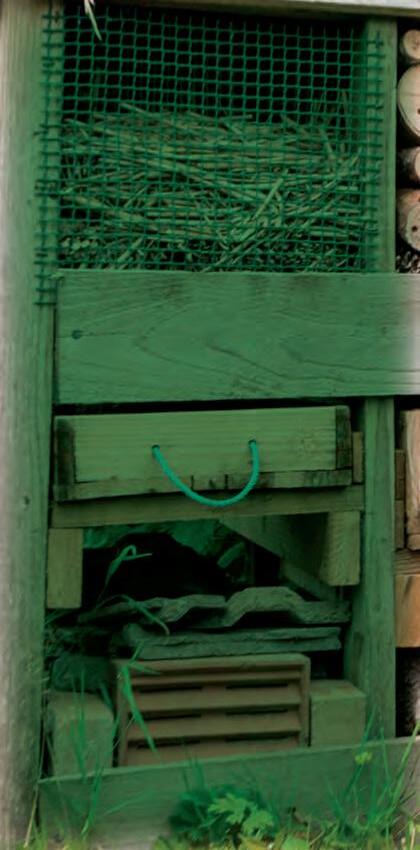
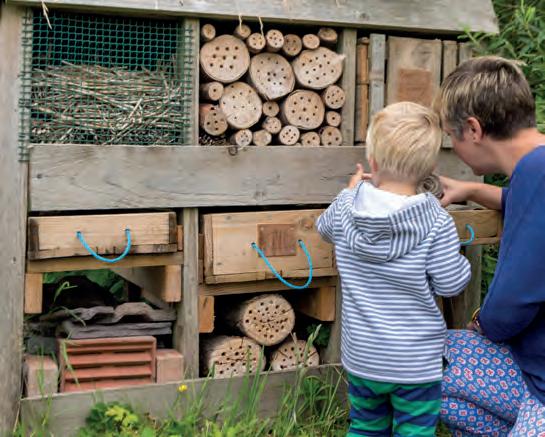
THE JOY OF POND DIPPING Little nature explorers – and big ones! – will love dipping a net below the surface of the water at our special ponddipping stations this spring. Spend time with family and friends trying something new, having fun and making new friends – from water beetles to fierce dragonfly larvae.
WHERE: WELNEY AND ALL CENTRES

The song of the skylark – that glorious cascade of liquid notes from a hovering speck – has inspired more poets than almost any other. Experience it for yourself on our saltmarsh, an area not generally open for public access, with our friendly, knowledgeable team in June.
WHERE: CAERLAVEROCK

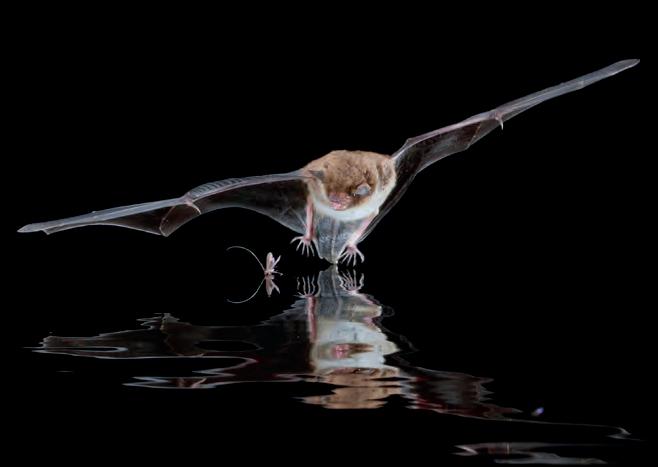
Did you know WWT London Wetland Centre is one of the best places in London to watch bats? And Thursdays in April are the time to see them! Around seven species – from tiny pipistrelles to large noctules – hunt over the lakes and marshes. Our exciting night-time bat walks give you the chance to see their astonishing aerial acrobatics, use a bat detector to listen to them ‘chattering’ and identify the species from their echolocation calls, and learn more about them from our bat experts. Book online. WHERE: LONDON

Discover more about our fascinating spring wildlife by joining our expert team for special guided walks around the wild reserve. Take in the season’s highlights – from grey herons to avocets to woodland flora – and learn more about how we create and manage a range of habitats to support important wetland wildlife. See the website and our social channels for dates and details of upcoming walks. WHERE: WASHINGTON
Spring is the best time of the year for birdsong – and WWT Castle Espie’s Birdwatch Morning is the perfect opportunity to listen and learn more. Join us from 10.30am to 12 noon on the last Wednesday of every month to enjoy a closer look at the birds on our reserve. As spring fluffs up their feathers, there’s lots of displaying and calling among the collection birds and the reserve will be alive with a chorus of chaffinches, robins, blue tits and maybe even a goldcrest.
From March to June, WWT Welney is opening its doors early so that members can exclusively enjoy the reserve from 9am.
WHERE: CASTLE ESPIE, WELNEY

Uplift your spirits and immerse yourself in the magical sounds of our wetlands for National Dawn Chorus Day on Sunday 7 May.
Learn how to identify the different songsters you hear on a guided Dawn Chorus Walk (6-8am) with one of WWT Llanelli’s friendly wardens, then enjoy a delicious cooked breakfast roll.
WWT London is one of the best places in the capital to enjoy the dawn chorus. On 22 and 30 April, our early morning guided walks start at 5.15am, so you can experience the birds’ vocal performance as the sun comes up.
Get up early and join WWT Slimbridge’s experts for a Birdsong Workshop (7-9.30am). Learn how to identify birds such as warblers by their calls and songs, then enjoy a breakfast roll in the Kingfisher Kitchen. We promise it’ll be worth the early start!
WHERE: LLANELLI, LONDON, SLIMBRIDGE

“Absolutely fantastic! Despite being WWT members and visiting Slimbridge often, my daughter and I had never been on the Canoe Safari. Lily, aged 11, adored it! We’ll be back!”
Gabrielle


Eachoneis availableas a 1000piece or400piecepuule.
Takenfromthe legendaryCityscapesMaps,therearean amazing99 UKtownsandcitiesavailablein theseriesto collect.


Eachdifferentjigsawfeaturesa stunninglyillustratedmap of the areaandall areavailableas eithera 1000piece jigsaw166cm x 50cmwhenbuiltl,or a 400piecejigsaw 147cm x 32cmwhenbuiltl.Forages8 to adult.

Isyourtownorcityavailable?Choosefromanyofthese!
Aberdeen Chester Alnwick Chesterfield
Bakewell Cirencester
Bath Cockermouth
Battle CoventGarden
Belfast Croydon
BerwickuponTweed Darlington
Beverley Derby
BexhillOnSea Dunbar
Birmingham Durham
Blackpool Eastbourne
Bournemouth Edinburgh
Brighton Exeter
Bristol Frame
BurySt Edmunds Glasgow
Cambridge Gloucester
Canterbury Grantham
Carlisle GreatYarmouth
Homcastle Hull
Inverness
Ipswich
Kendal Keswick Leeds Leicester Lincoln Liverpool London Louth
Cardiff Harrogate Hereford Hexham
Mablethorpe Maidenhead Manchester MarketHarborough Newark
Cheltenham HenleyonThames Newbury
NewcastleuponTyne
Norwich
Nottingham
Otley
Oxford
Peterborough
Plymouth
Preston Reading
Retlord
SaffronWalden
Salisbury
Scarborough Sheffield
Skegness
Skipton
Sleaford
Southampton Southport
Stamford StAlbans
StAnne'sontheSea St Ives
StocktononTees
StratforduponAvon Street
Sudbury
Taunton
Telford
Torquay
Wakefield
Wells
Whitby
Wilton Windsor
Worcester
Worthing
Southwell York
Pleaseallow14daysfordelivery.Pleasenotethatasthesepuzzlesaremadeto orderindividually, theyarenotrefundable,unlessthereisafault
Remember10 quote WLF9A 10 get your SPECIALOFFERprice

RealAle,RealFoodPubwith 14well appointedensuitebedrooms ENGLISHTOURISTBOARD4*
10MinuteStrollfromWWT Slimbridgeandsituatedadjacent to Gloucester-SharpnessCanal CaskMarqueaccreditedsince2015.
T: 01453890306
E:enquiries@thetudorarms.co.uk W:www.thetudorarms.co.uk
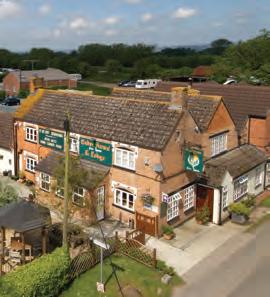

In a lovelyvalleyin the PembrokeshireCoastNational Park,Victorian-builtRosemooroffers characterful accommodationin spaciousgrounds.Unpolluted beaches,Skomerand tidal wetlandsnearby12miles!. Our own 30-acreNatureReserveis hometo badgers, otters and a greatvarietyof birds and plants.
John M. and JacquiJanssen
RosemoorCountryCottages & Nature Reserve
Walwyn'sCastle
HavefordwestSA623ED
Tel:01437-781326
E-mail: rosemoor@walwynscastle.com www.rosemoor.com
Cosy, clean character lets for two. Ideally situated on the doorstep of WWT Steart and Stockland Marshes, working wetlands that are attracting unusual avian visitors such as black winged stilts, avocets, spoonbills and glossy ibis. Beautiful peaceful setting, perfect for bird lovers, ramblers and cyclists.

Address: Mill barn Stockland Bristol Bridgwater Somerset TAS 2PY
Phone: 07906722312 or 01278 653073
Email: the.carrolls@live.co.uk
Website: https://www.millbarnruralretreats.com
Groundfloor flat for two in
Glencapleclose to WWT.Verycomfortablewith wood-burning stoveand small sunnygarden.In winter barnaclesfly past morning and eveningand are seenfeeding on the merse. Flocksof ducks and waders are here in large numbers. In summer ospreysnest nearby.Goodwalking and cycling.
www.glencapleholiday.co.uk
tel: 01387 7703,a email:sue_greigrayahoo.co.uk



Quiet, peaceful area, perfect for walking and bird watching. Ideally placed for visiting Martin Mere and Mere Sands Wood nature reserves and Formby Point on the coast. 4 * Barn Owl Cottage sleeps 4, Maltkiln Cottage sleeps 2.
www.crookhallfarmcottages.co.uk 01704 822389


Holiday Lets set within a National ScenicArea of outstandingbeauty availablefor short breaksor weekly bookings,all within 1/2 mile of WWT Caerlaverock, NNR and CaerlaverockCastle
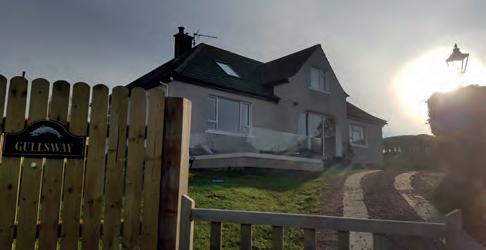
A nature loversparadise. The migratinggeesegraze in the surrounding.fieldsaround the properties.
E-mail: jamiecowan2000@yahoo.co.uk
Telephone: 07711583320
www.caerlaverockcottages.co. uk










Waterlife chats to Paralympic gold medallist and WWT member Jo Frith about how she discovered a deeper connection with wetlands



When I was 11, my family moved to Somerset. This was when I realised how much I loved the countryside. I had a Saturday job on a farm and I adored being out in the fresh air.
Until now I’ve taken wetlands for granted. I live on the edge of the Somerset Levels and am always busy with work and sport. I never found the time to just sit quietly watching birds or explore what was right there in front of me.
I first visited WWT Slimbridge about 30 years ago. But last year, I fell in love with it. I feel at peace here.
Being in a wheelchair means I’m low to the ground. So when I’m wheeling around Slimbridge I feel immersed in the environment. I can’t see over the top of the reeds but I can look through them. As I go round a corner, each view is new because I can’t see what’s ahead.
I’m amazed at the variety of visitors – families with children, young couples, birdwatchers with scopes and also people like me, just discovering the centre’s delights.

I became a member because we’ve lost so much wildlife and so many natural habitats in the UK, WWT’s conservation work is invaluable. It fights hard to protect wetland habitats and their special wildlife. I want to support its efforts.
As a member, I can visit WWT sites for free, so I can go as often as I like. Slimbridge and Steart Marshes are both local to me. All the paths are accessible to wheelchairs and also to people who have difficulty walking. There are accessible hides at both sites, which means I can visit them on my own and be independent if I want to have a bit of peace and just watch birds.
I like that I can take my time, exploring at my own pace and finding out about the birds I see. I’m not good with the fast-paced hustle and bustle of life, so I love leaving it all behind me when I go to a WWT site. It’s so peaceful, you can forget about everything else.
Nature is for everyone. The opportunity to enjoy seeing wildlife in its natural environment should
not be dependent on your physical mobility. Being out in the open air, appreciating birds and plants, has positive mental benefits and should be accessible to everyone.
I think being around water is therapeutic. Maybe it’s to do with the sound of water – it’s so constant and rhythmic.
As a competitive swimmer, I’ve done a lot of open-water swimming in the sea and in lakes. I love it because as you get in the water the cold takes your breath away – and when you get out and start to warm up, the feeling of invigoration makes you feel alive and ready to take on the world.
Wetlands and the wildlife they support are unique, but they’re being destroyed at an alarming rate. We have a responsibility to protect them for generations to come. Through my membership, I hope WWT will fight for wetlands, using its expert voice, skills and knowledge to lobby on their behalf. Collectively we have a bigger voice and we can make change happen.





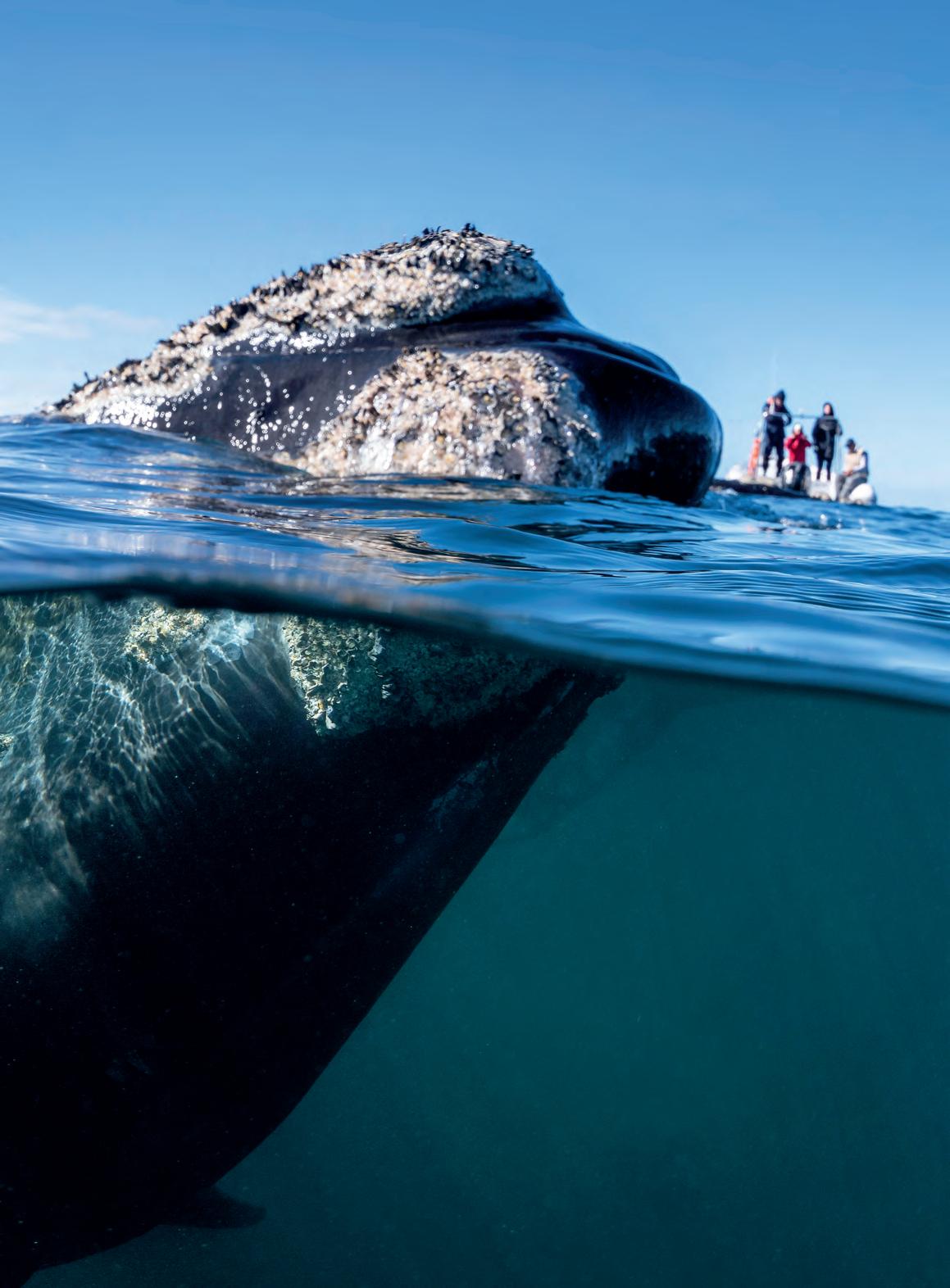





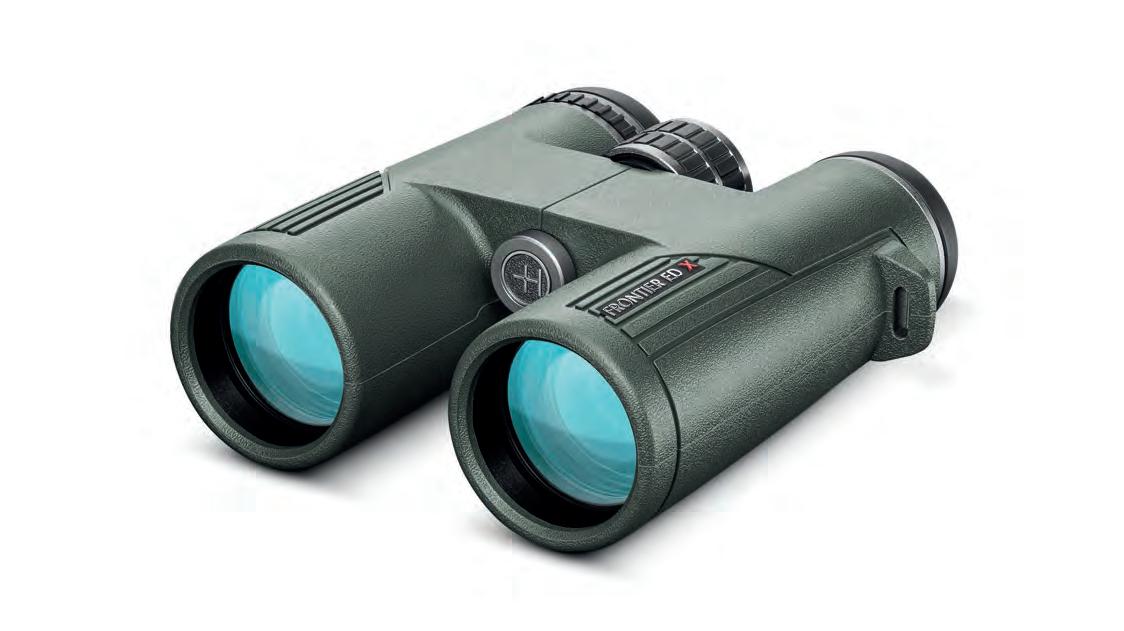
"Brilliantoptics,acommonsensedesignthatputsuser-friendlinessfirst."